
I’m regularly asked by other gardeners what my favorite heat-loving, deer-resistant perennials are, and what has survived year after year.
Even though I’ve written a lot about my favorites, I’ve combined my various posts into one article, adding FIFTEEN new tough-as-nails perennials.
I’ve also indicated if they bloom early 0r mid-summer (or both!) Click here to read about late-summer bloomers.
It’s important to keep in mind that the appetite of deer vary region by region (sometimes within a relatively small area) so experiences will differ.
Not to mention the time of year. Late fall (after a long, hot summer) hungry deer will eat just about anything.
However, this list is what I’ve found successful over several decades.
So drumroll, please – here they are, all in one place! My favorite heat-loving, deer-resistant perennials that will tolerate a blistering hot summer!
1. Stokesia ‘Blue Frills’ (Stokes Aster) zones 5-9, deer-resistant, blooms early summer

When the stokesia blooms in my garden, that’s my signal that summer has begun!
Many traditional varieties are in shades of light blue), but check out the color of ‘Blue Frills’! These flowers are a vivid bluish-purple on upright stems with dark green foliage – a welcome addition to the parched garden.
The flowers are HUGE (3-4” across) and bloom once the garden really starts to heat up in mid-summer.
Tons of pollinators adore this plant, and whenever I need a photo of a butterfly, I head out to the stokesia.
They’re a perfect front-of-the-border plant, growing to 2’x2’ and are happy in my BAKING HOT sunny border.
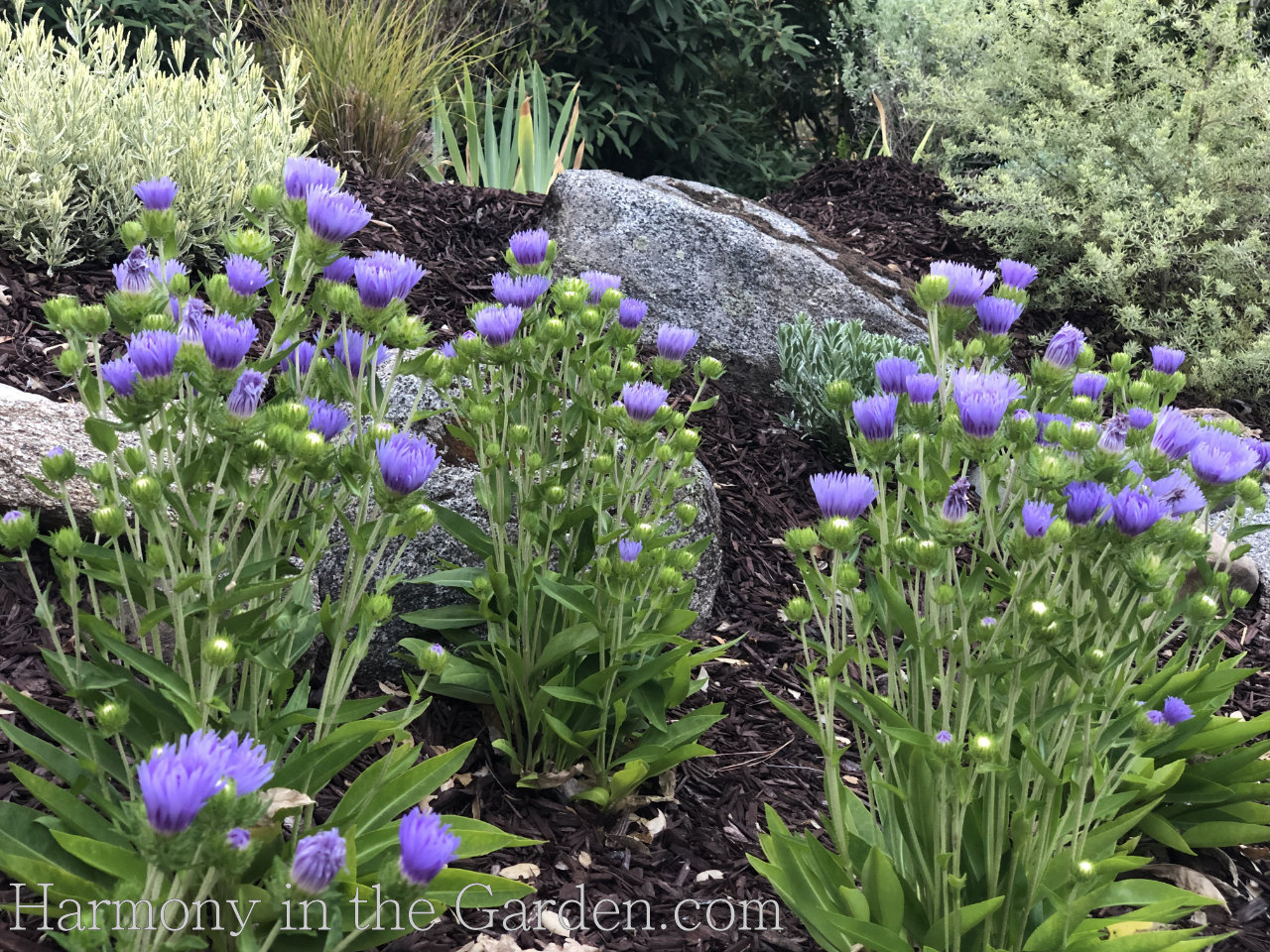
2. Monardella macrantha ‘Marian Sampson’ (Scarlet Monardella) zones 6-10, deer-resistant, blooms early and mid-summer
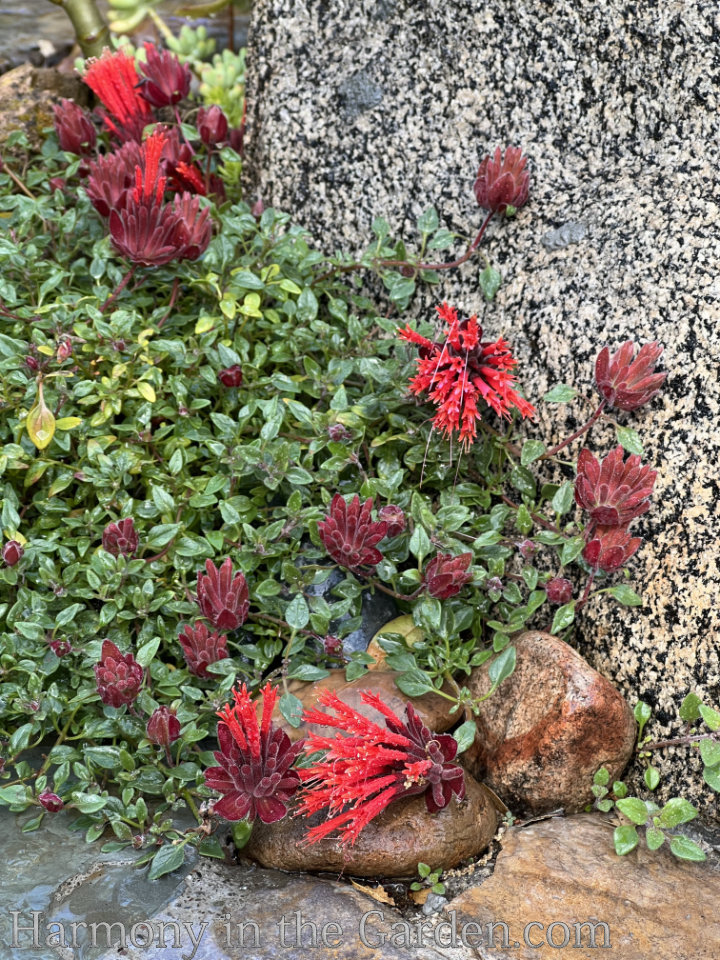
This little perennial is actually evergreen in my garden, growing to a tidy 6″ x 12″ wide.
It’s the perfect sun-loving perennial to add to tight corners (like in this space between my patio and giant granite boulders.)
Despite its size, you can spot the vibrant red blooms across the garden. It’s profuse 2-inch clusters of feathery tubular flowers beckon to every hummingbird around!

3. Cosmos atrosanguineus (Chocolate Cosmos) zones 9-11, deer-resistant, blooms early and mid-summer

One of my favorite perennials of all is the Chocolate Cosmo.
On a warm day, the velvety maroon flowers have a delicious vanilla-chocolate scent that butterflies can’t resist.
It’s a warm-climate perennial that really comes into its own once the temperatures heat up.
For those of you who live in colder climates, you can dig the tubers to store over the winter, or treat as an annual.
I particularly love this planted near grasses, with the 24″ wands mingling together with the blades of grasses.
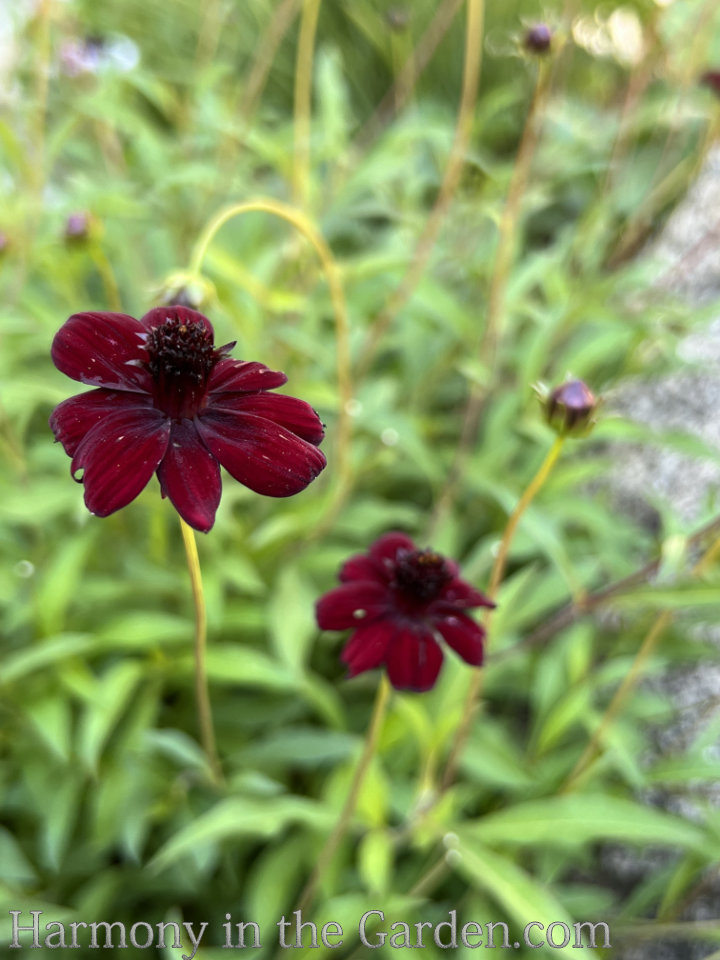

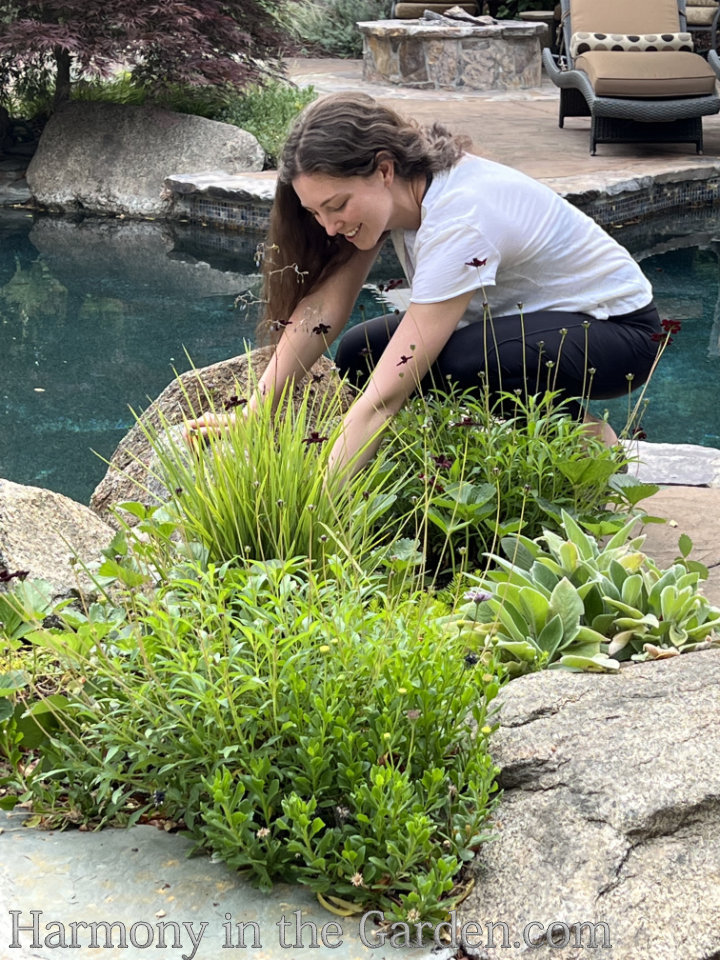
I have Chocolate Cosmos throughout my garden, but some of my favorites are planted in a little garden bed that borders my pool.
A few years ago, my daughter begged me to plant strawberries in this bed so she could swim up and have a snack (or, simply forage for them when she’s hungry…)
This is my garden’s version of Chocolate-Covered Strawberries! 😉
4. Helichrysum amorginum ‘Ruby Clusters’ (Strawflower or Curry Plant) zones 8-11, deer-resistant, blooms early and mid-summer
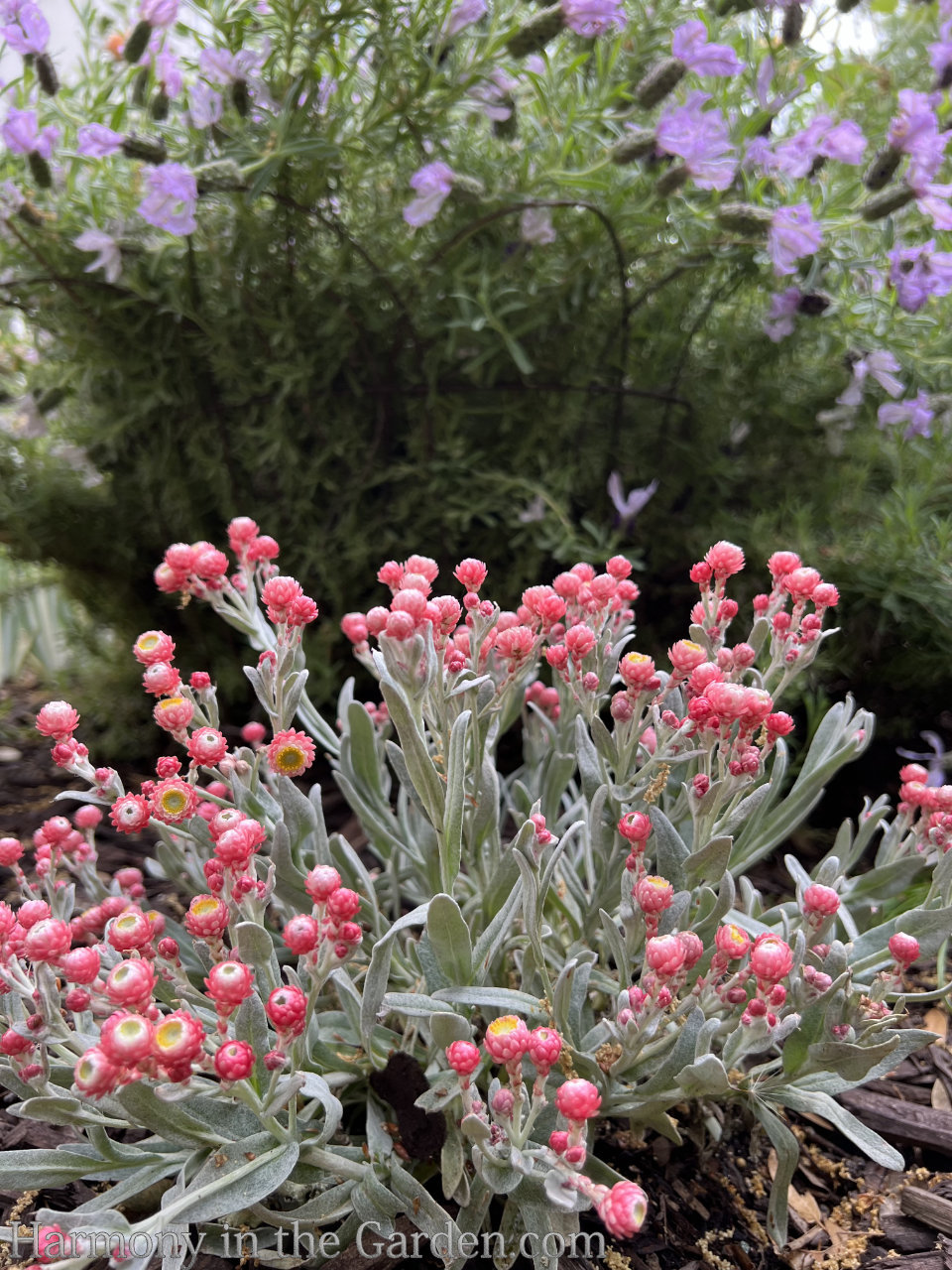
If you’ve got a hot and dry spot at the front of the border, you might consider ‘Ruby Clusters.’
Growing to just 10″ x 16″, the silver foliage ‘pops’ when surrounded by other green plants.
But once the dark pink buds first appear in the spring, that’s when the show starts.
The flowers start out as little ruby-red balls, then open to pink, then morph to soft yellow. They’ll remain on the plant for another 4 weeks (or until you dead-head them.)
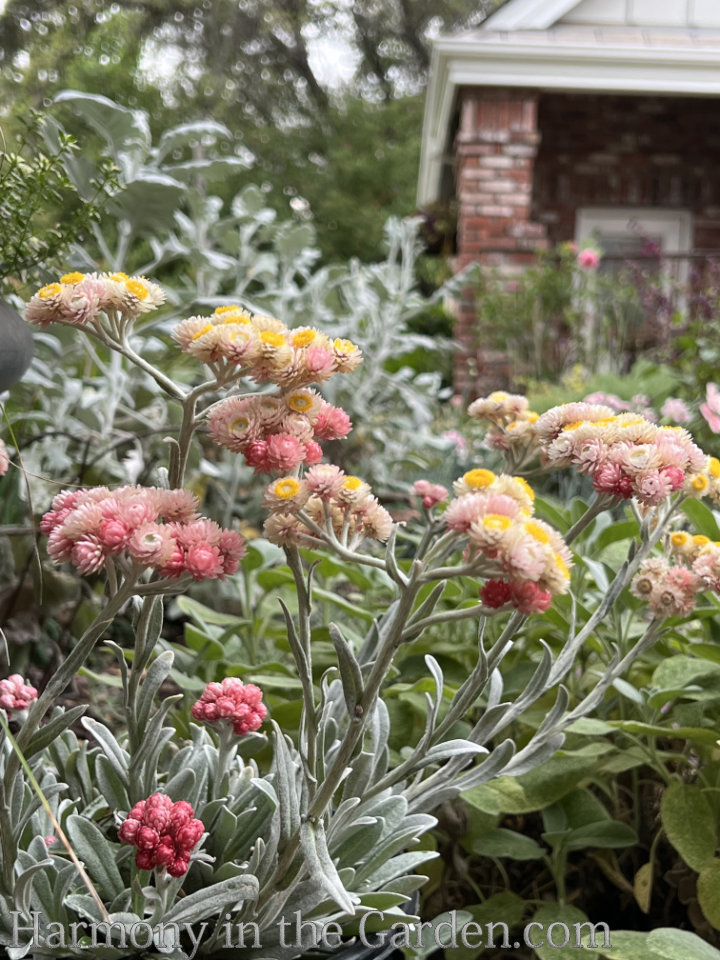

These little helichrysums have performed so well for me that I’ve now added a new variety to my garden – ‘Ember Glow’.
I just love the soft apricot balls that first appear (don’t they look fantastic with the orange-red berberis behind it?)
Several years ago, I grew a different variety of strawflower from a small cutting (below.) This is helichrysum italicum and I SO appreciate it’s long-lasting bright yellow blooms and curry-scented foliage. I leave the faded flowers on the plant for another few months, appreciating the soft tan colors, until I finally trim them back.
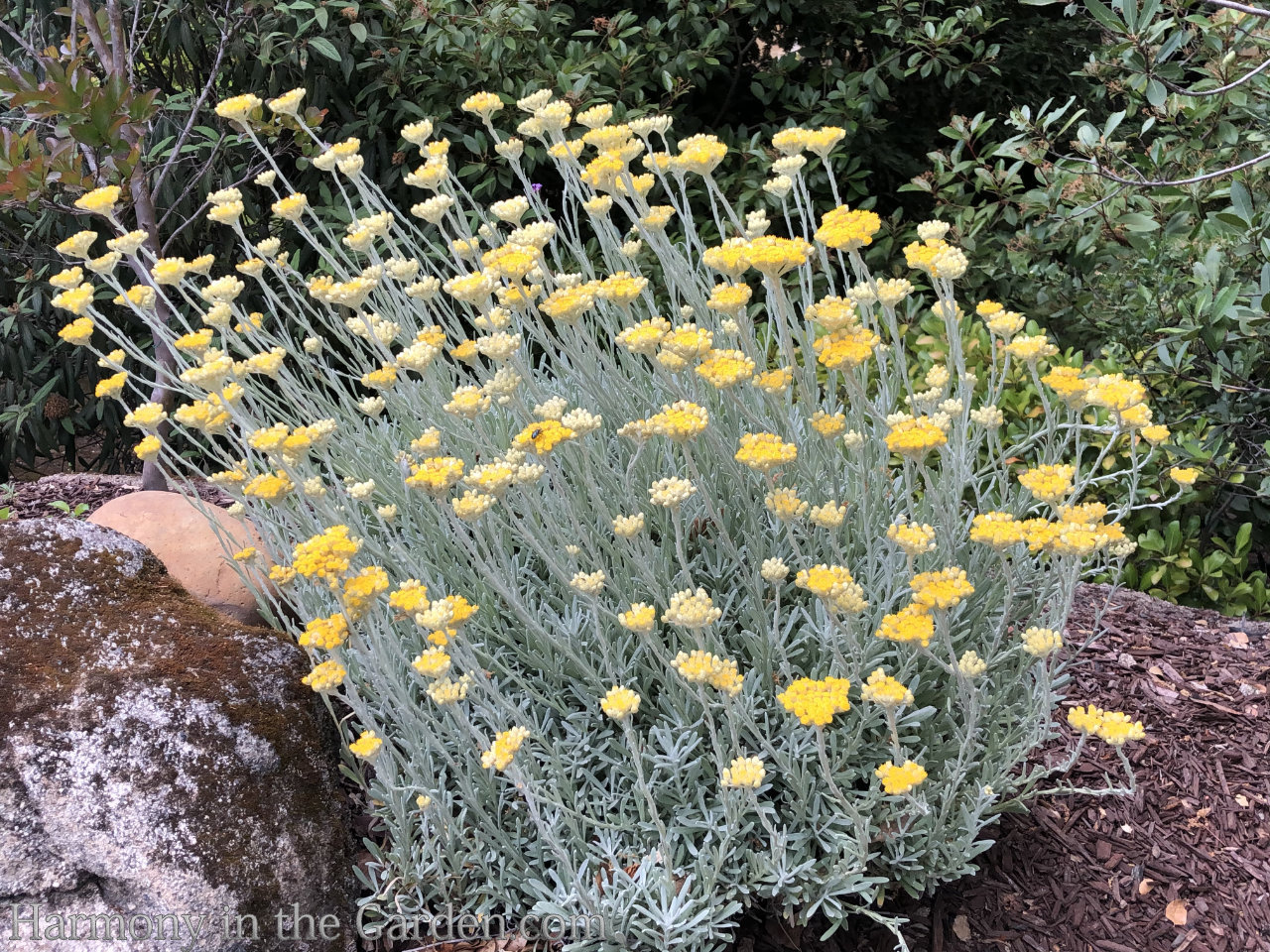
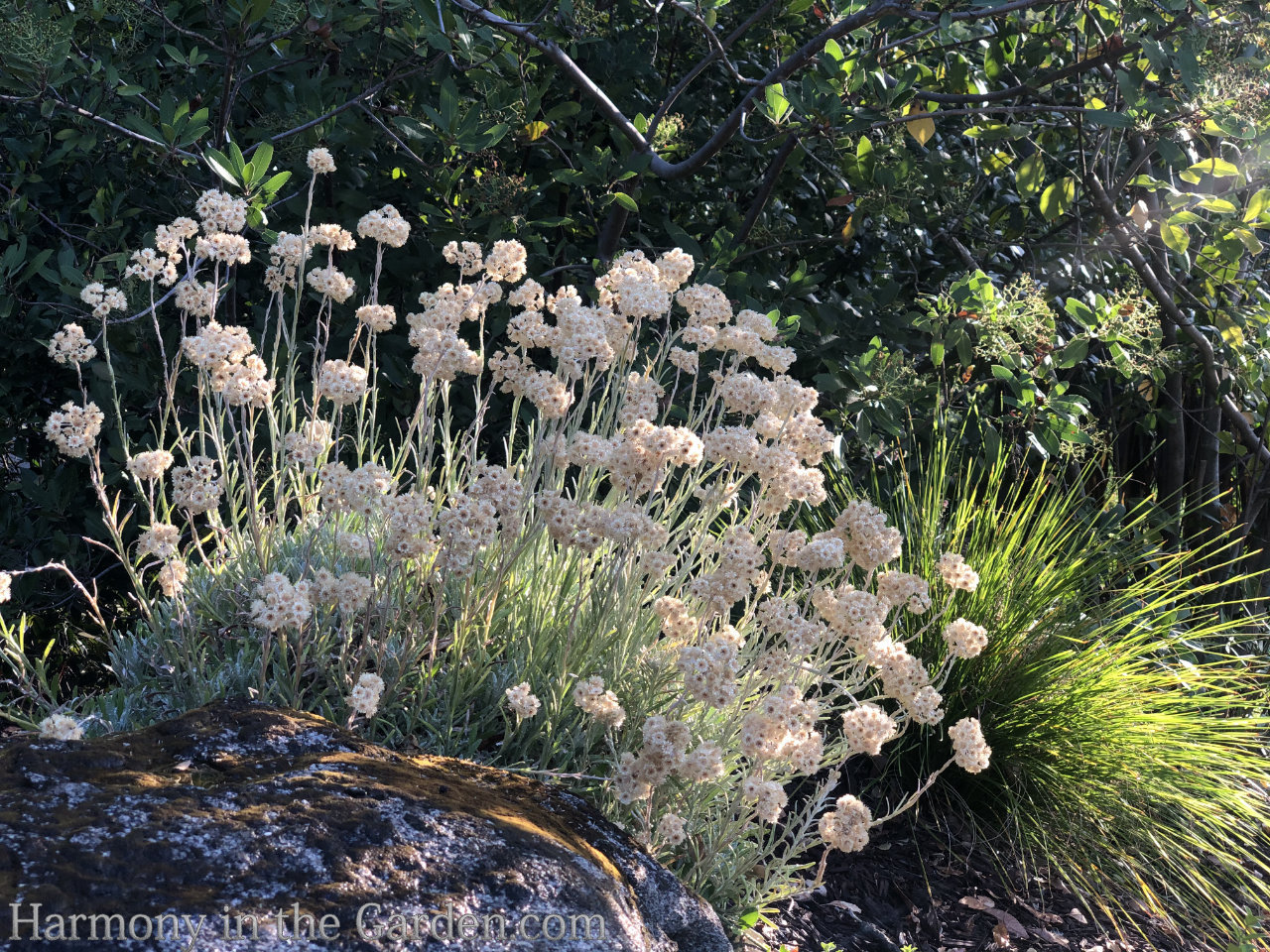
5. Calylophus hartwegii ‘Texas Gold’ (Sun Drops) zones 5-9, deer-resistant, blooms early-mid summer
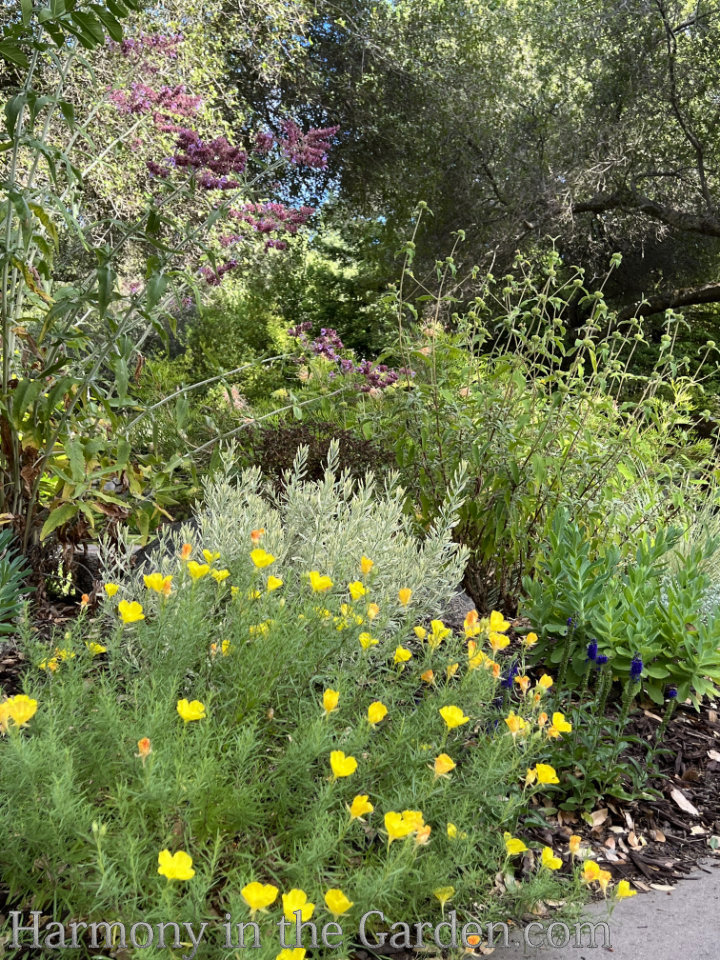
This tough little Western native is covered with cheery yellow blooms that bees adore.
I planted this one a few years ago, and every summer it blooms for six months straight before taking a much-needed rest. SIX MONTHS!
Sun Drops prefer well-drained soil and full sun and are very drought-tolerant.
Sun Drops even tolerate reflected heat, making them ideal to plant next to a hot driveway.
Once it stops flowering, I cut it back by 1/2 to give it a rest before it ramps back up again in a few weeks.
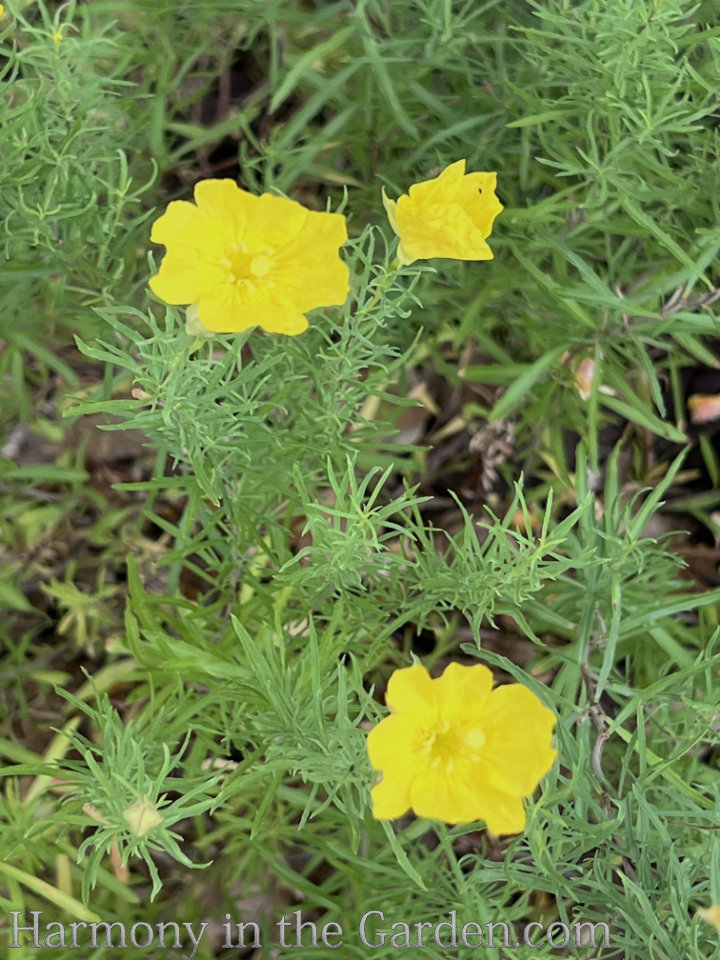
6. Platycodon grandiflorus (Balloon Flower) zones 3-9, deer-resistant, blooms early-mid summer
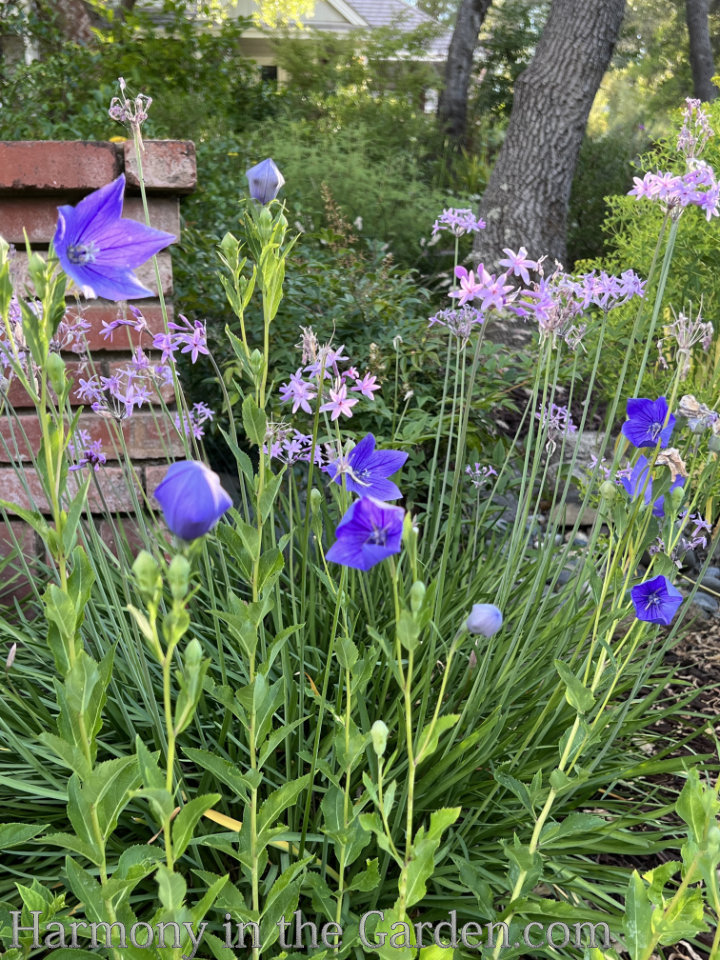
For three years I nurtured these little plants that I grew from seeds collected many years ago. Patience paid off!
Thankfully, once they decided to stick around, there seems to be no stopping them, and each year they grow more and more robust.
Take one look at the flower bud, and you can see why it’s called ‘Balloon Flower.’ But it’s the crazy colors (below) that randomly appear on the flowers that I love most.

7. Senecio cineraria (Dusty Miller) zones 8-11, deer-resistant, blooms early-mid summer
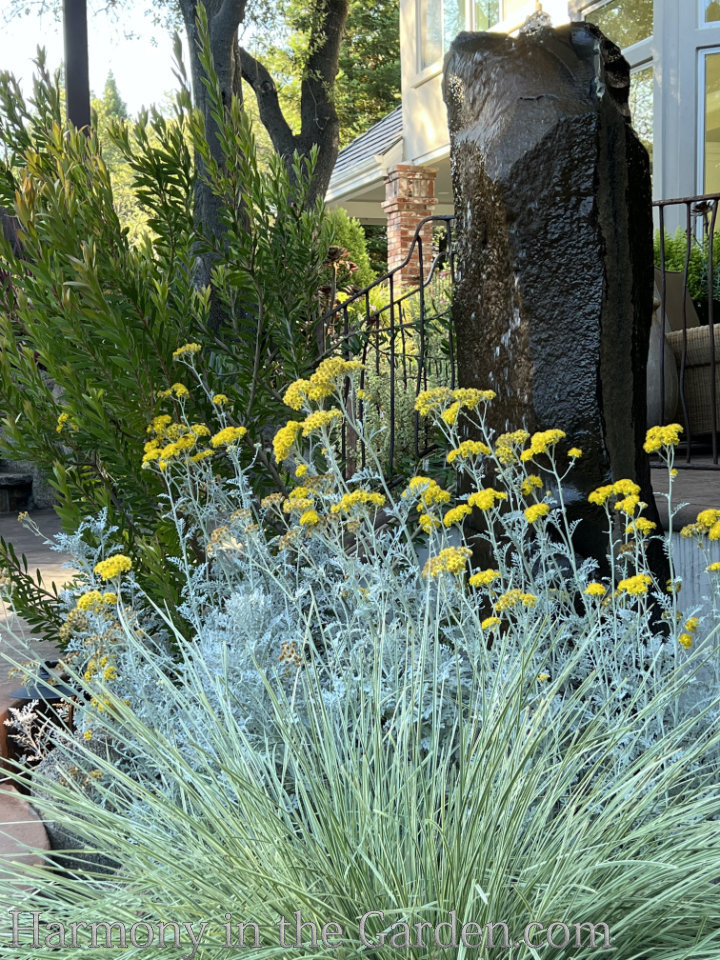
This is the one area in my garden that doesn’t receive any irrigation at all (click here to see some truly awful ‘before’ photos!)
And while I ‘try’ and keep it watered, in reality it only receives a bit every few weeks.
Boy, oh boy, is this senecio tough! This particular grouping is going on three years old now and all it asks of me is the tiniest bit of love.
It blooms for several weeks at a time and when finished I dead-head it, perhaps cutting it back by 1/3, and that’s it!
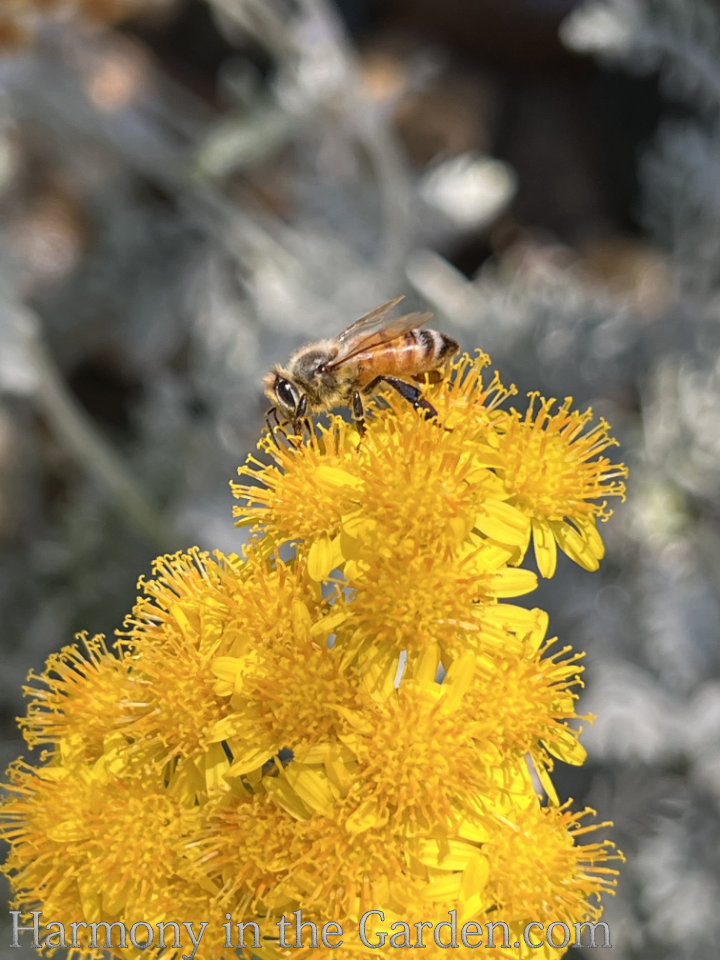
8. Agapanthus (Lily of the Nile) zones 8-10, NOT deer-resistant, blooms early summer
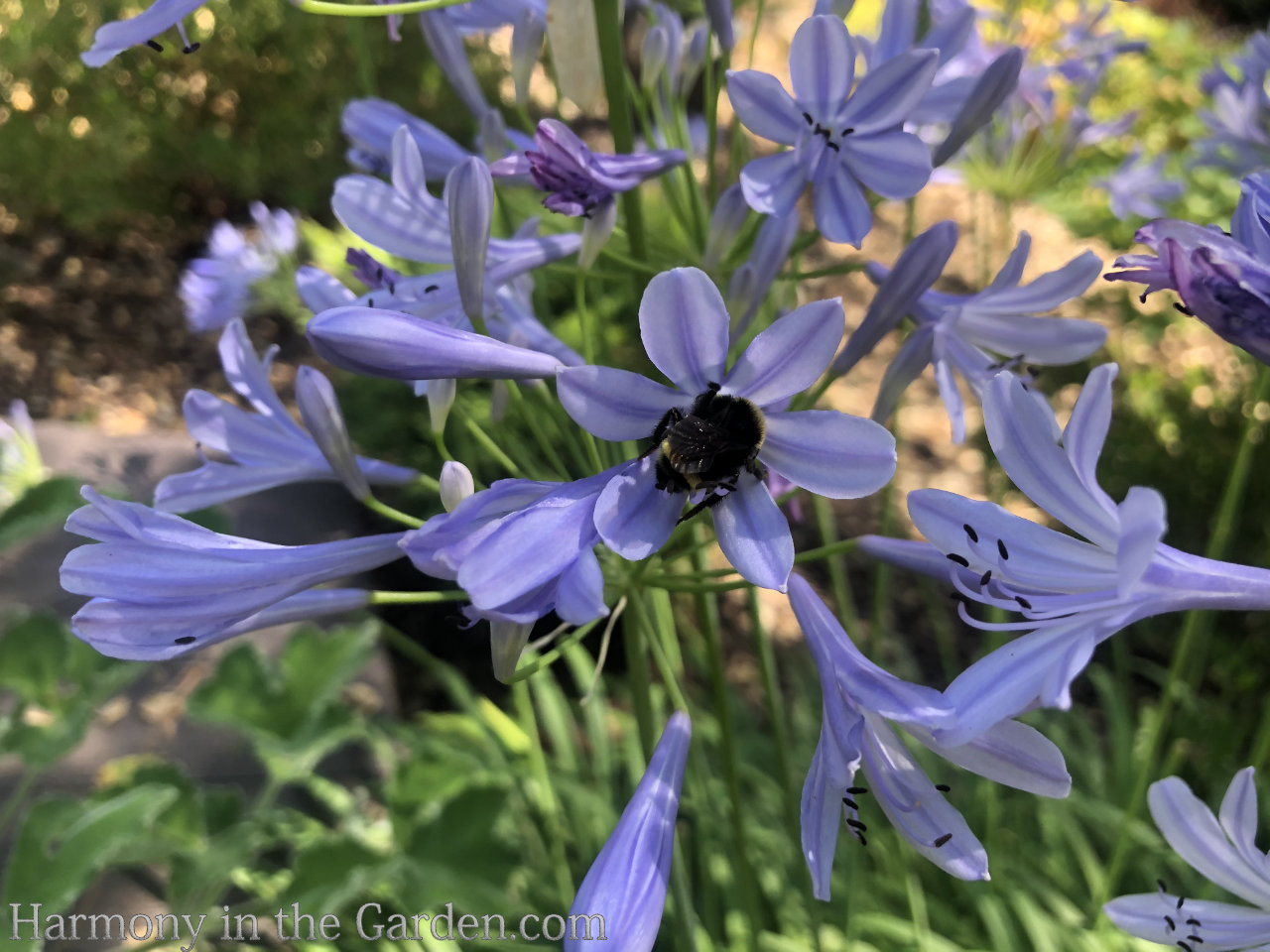
Confession time: In the past, I wasn’t a huge fan of agapanthus because (I’ll admit) they’re just so darn common. They seem to grow everywhere here in California to the point of being a bit boring.
After moving to my new garden and experiencing all the new challenges I’ve had to face (intense heat, browsing deer, non-functioning irrigation system, etc.) I’ve had a change of heart.
I LOVE AGAPANTHUS! Anything that showers me with flowers with little to no attention from me has my vote!
Over the past few years, I’ve tried a few new varieties from Sunset’s Plant Collection, which have risen to the top of my list.
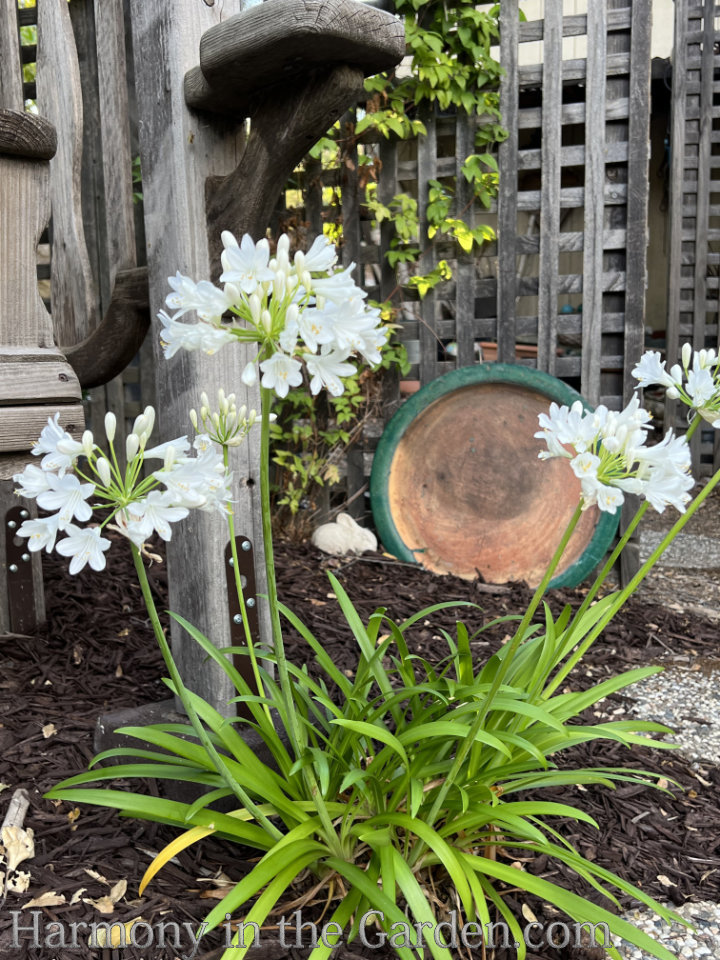
The first is Sunset’s agapanthus ‘Ever White,’ which is a sweet little dwarf variety, growing to just 1 ½’ x 1 ½’.
I love the small size, as many common varieties grow to gigantic proportions (I have old clumps here that are at least 6’ wide and 6’ tall when in bloom!)
‘Ever White’ is perfect for the front of the border, and the crisp, cool white flowers are a welcome sight on a sweltering hot day.
And did I mention they re-bloom? This means I can enjoy the flowers throughout the summer, instead of other varieties that bloom only once.
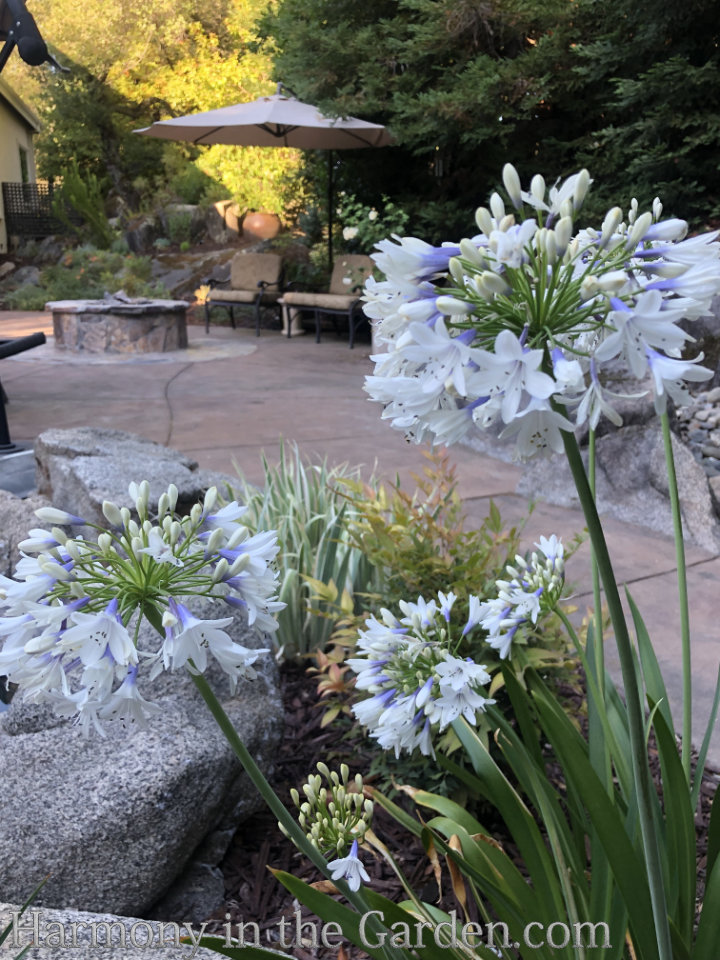
The second variety is ‘Indigo Frost,’ which has to-die-for blue and white flowers that stand out among the more typical shades of solid blue.
It’s a little taller than ‘Ever White’, growing to about 2’x2’ (add an extra foot once the flowers start to bloom.)
While agapanthus flowers are like candy for deer, they tend to leave the strappy leaves alone.
So, once the flowers begin to bloom, I spray the plant with Deer Out, and it works like a charm – deer stay away for weeks at a time.
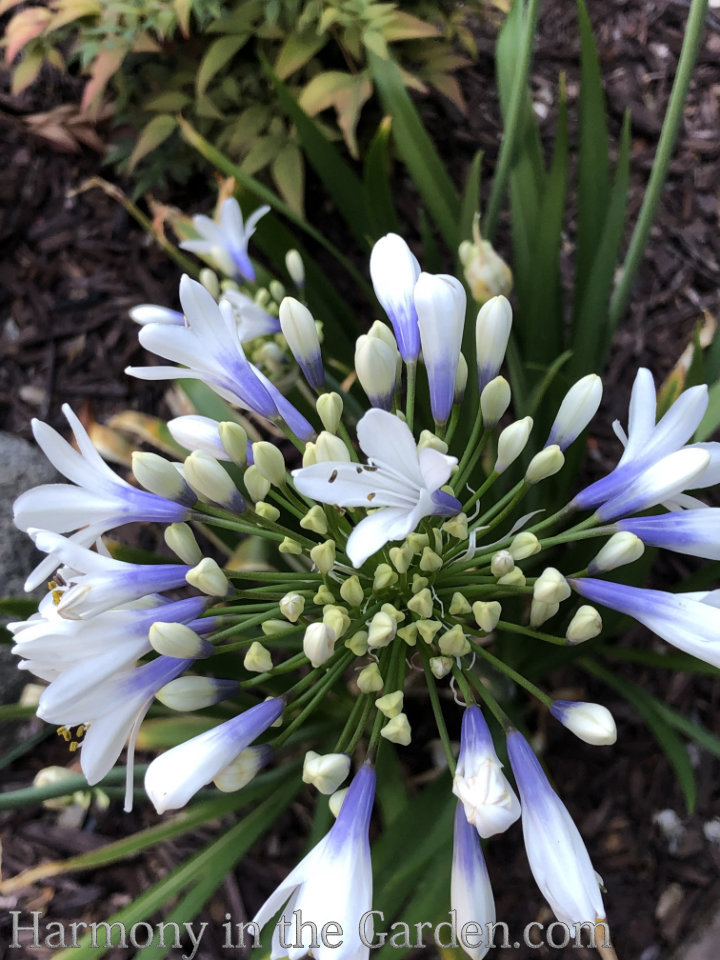
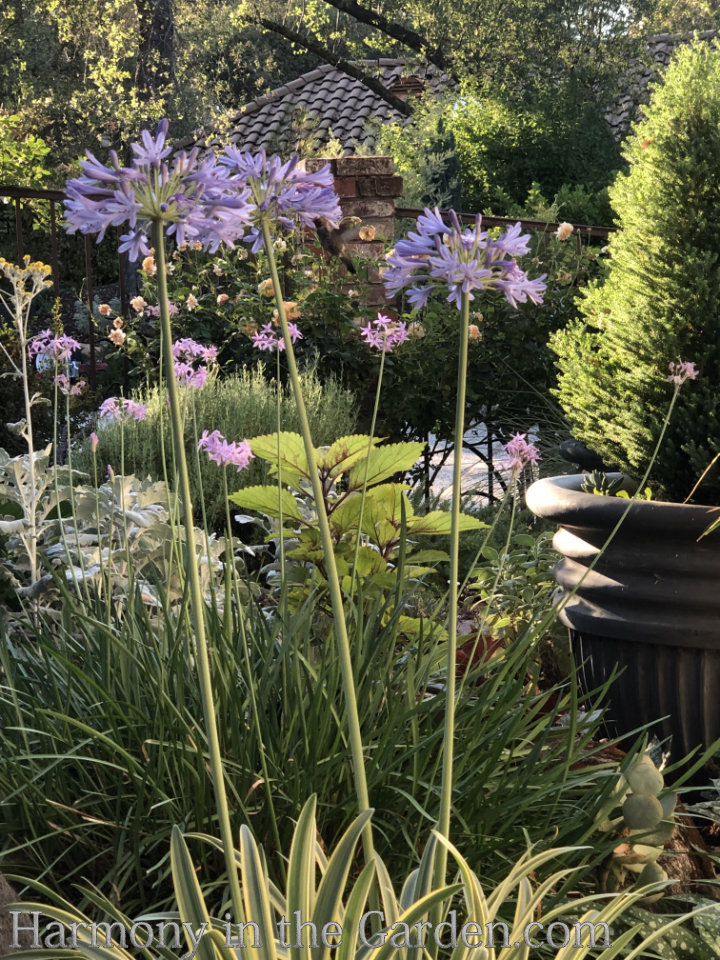
The other variety I love is ‘Summer Sky’, which I found (of all places) at Home Depot. I’ve since seen many variegated varieties in the nurseries that look the same but with different names.
I originally bought it for the foliage, and how it complemented the blue succulents (below) but the tall blooms of light blue flowers are just as lovely.
The hummingbirds think so, too (if you look closely you can see one on the middle flower, left.)

9. Phygelius CandyDrops ™ Tangerine (Cape Fuchsia) zones 6-9, deer-resistant, blooms early-mid summer
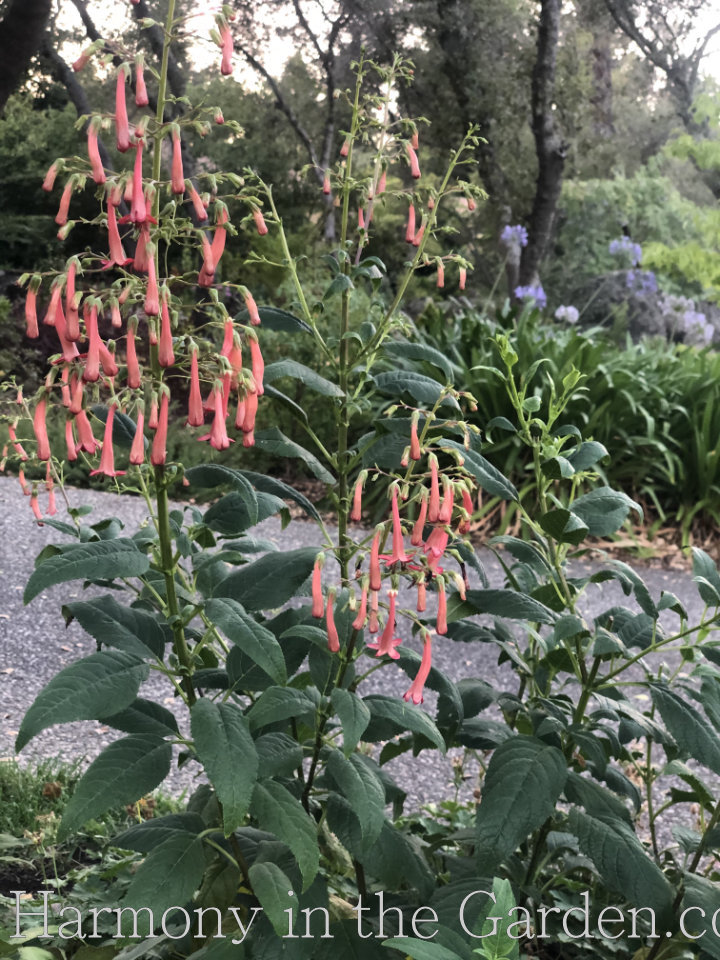
This compact variety was originally bred for containers, where mine lived for several years. When I moved up here five years ago, I looked in an oversized container that I had brought with me and saw that I must’ve stuck it in there (temporarily, I’m assuming) for the move up here.
It bloomed and bloomed with TOTAL NEGLECT on my part (I was busy unpacking and all the chaos that comes with moving), so I decided to rescue it and plant it in the garden.
Since then, it’s rewarded me with weeks and weeks of soft apricot blooms.
It’s smaller than other more common varieties (which can grow up to 4’ and can often look woody & unkempt) and tops out at about 2-feet.
It’s happiest in partial sun (especially in my hot climate), with moderate water (it’s planted near the bottom of my garden to take advantage of the overspray from a nearby lawn.
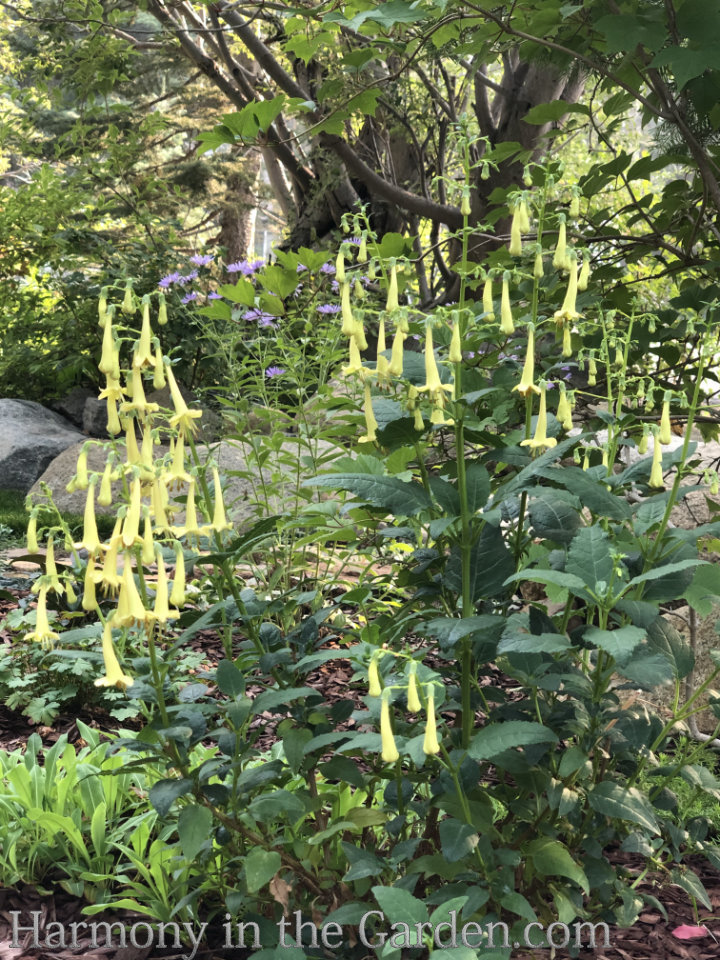
Another fantastic variety to try is Monrovia’s phygellius Colorburst Yellow, with TONS of nectar-rich tubular flowers that hummingbirds adore.
This variety is planted in our Lake Tahoe garden (zone 6) and has so far survived the crushing snow (knocking on wood!)
In my last garden, I planted CandyDrops ™ ‘Red’ in a window box placed just outside of my office window, and loved to watch the hummingbirds while I worked. (click here to see four different versions of my window box.)
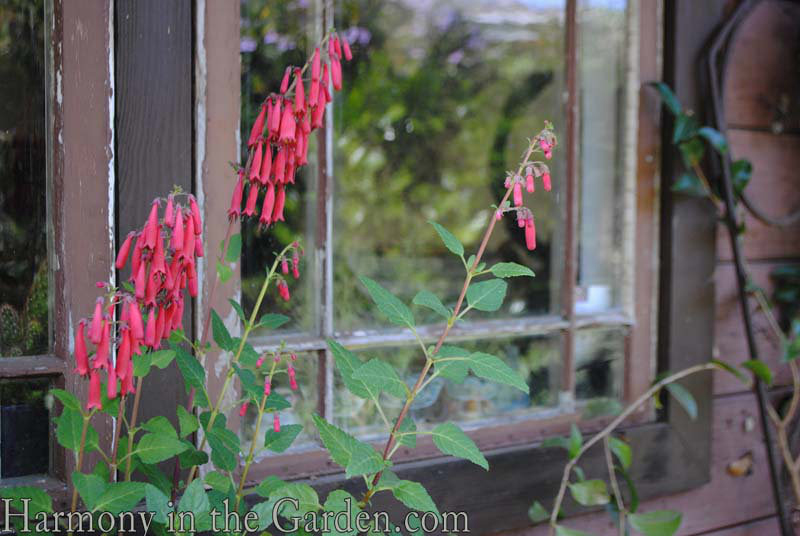
10. Euphorbia ‘Charam‘, zones 6a-9, deer-resistant, blooms early-mid summer
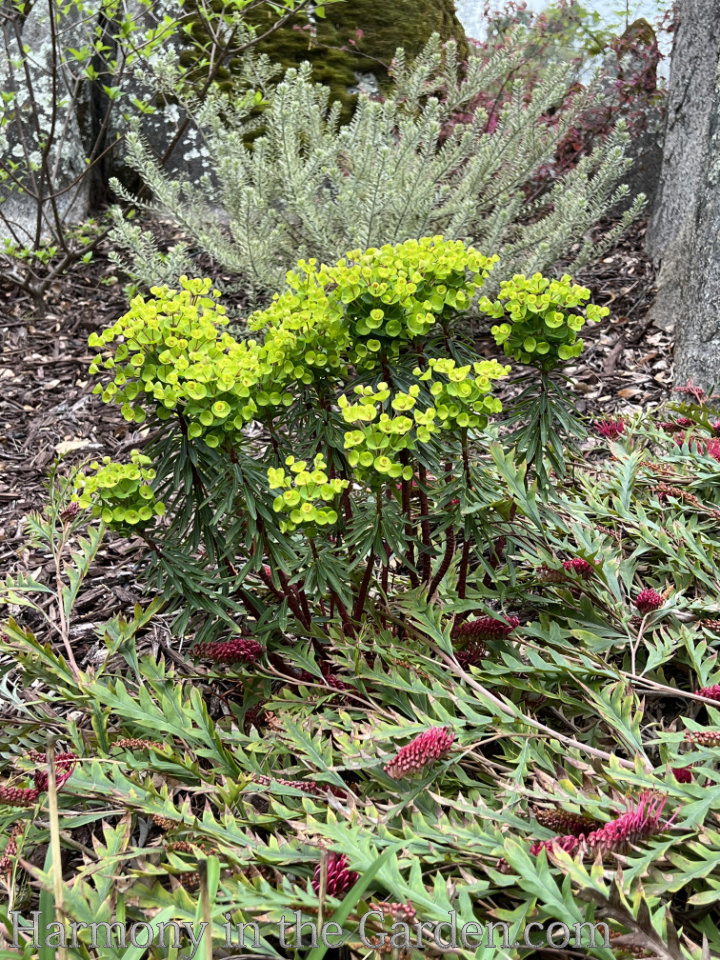
If you’ve read my blog for awhile, you probably know I can’t garden without my euphorbias! (click here to read about my other favorite varieties that thrive in my garden!)
They’re SO tough in our area, requiring very little water, resisting browsing gophers/bunnies/deer, and are evergreen in our mild climate.
‘Charam’ is a wonderful (though sometimes hard to find) variety, growing to just 2’x2′.
It’s an English hybrid (a cross between e. amygdaloides and e. martinii) with a very compact form, and long blue-green leaves.
But it’s those lime-green blooms that get me every spring, causing me to swoon for weeks!
The blooms fade throughout the summer, but remain green until the early fall (which is why I’ve included it in this summer-blooming list.)
11. Anigozanthos (Kangaroo Paws) ‘Harmony’ & ‘Tequila Sunrise’ zones 10-11, deer-resistant, blooms early to mid-summer
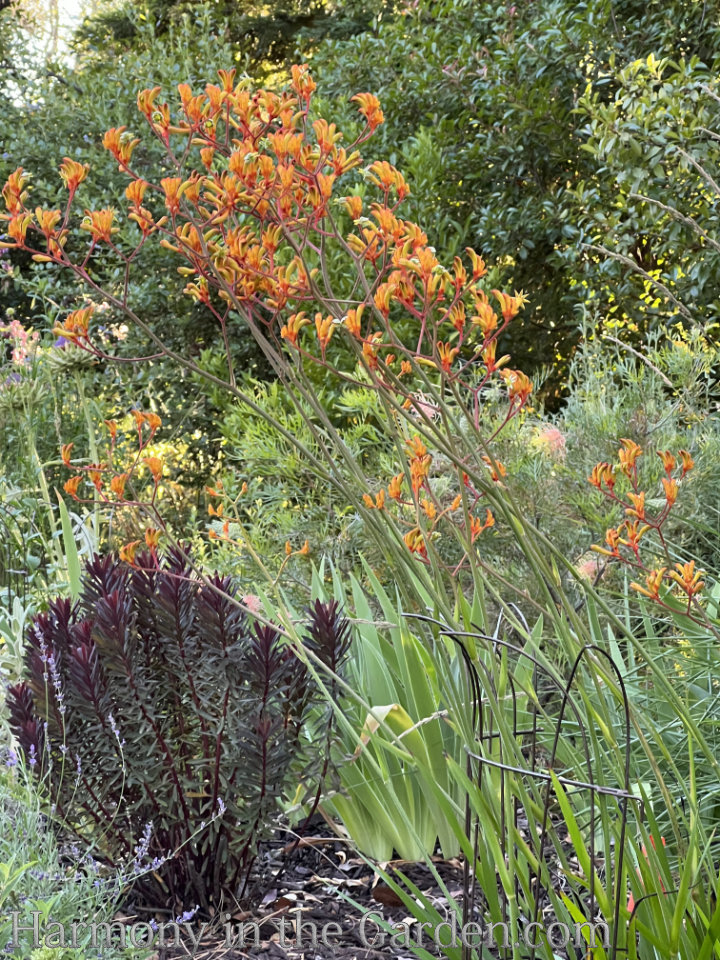
For those of you who garden in colder climates, I’m sorry to tempt you with these tender beauties (maybe you could grow them as annuals?)
Personally, I’d be lost without them in my garden and those that I design.
While there are lots of varieties in the nurseries, in my experience, the only ones I bother with are the yellow ‘Harmony’ and the orange ‘Tequila Sunrise’ (sometimes ‘Big Red,’ too.)
These are the really tall ones, growing to 5’, and have proven to be the most reliable, returning each year bigger and better than the last.
Kangaroo Paws reign from Australia (the name gives it away, right?) so you know they’re TOUGH.
The hottest days don’t phase them, and they want very little water (in fact, too much is the kiss of death for them.)
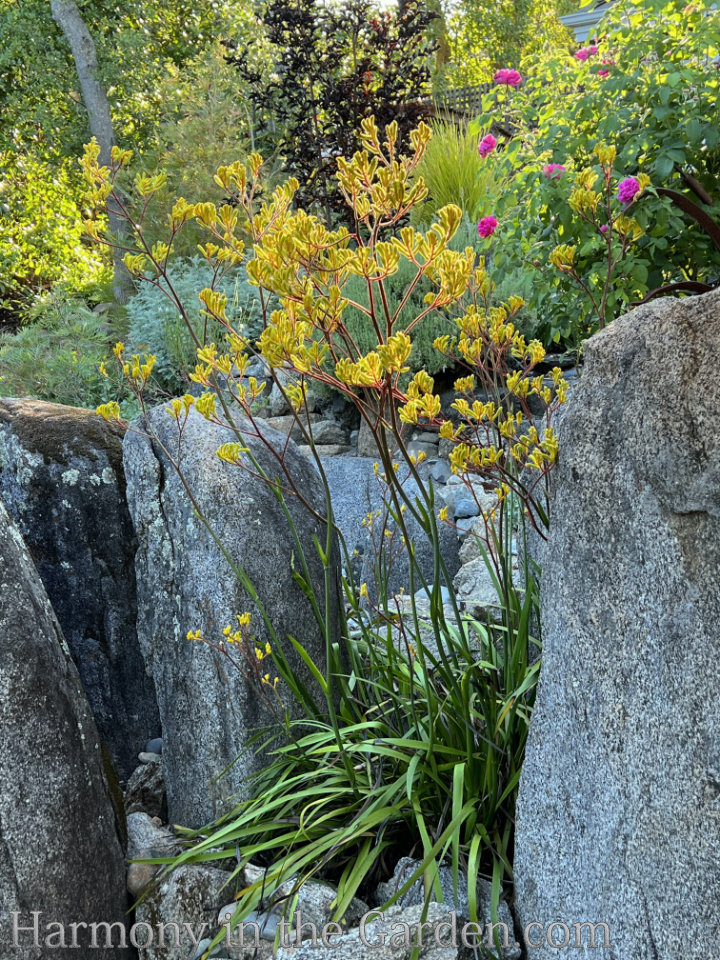
In the photo, left, I’ve tucked the yellow ‘Harmony’ in very tight spaces naturally occurring between the existing granite boulders.
As I knew the soil would be shallow and fast-draining, they were the perfect choice for these spots.
Oh, and did I mention they’re a favorite among hummingbirds (below?)
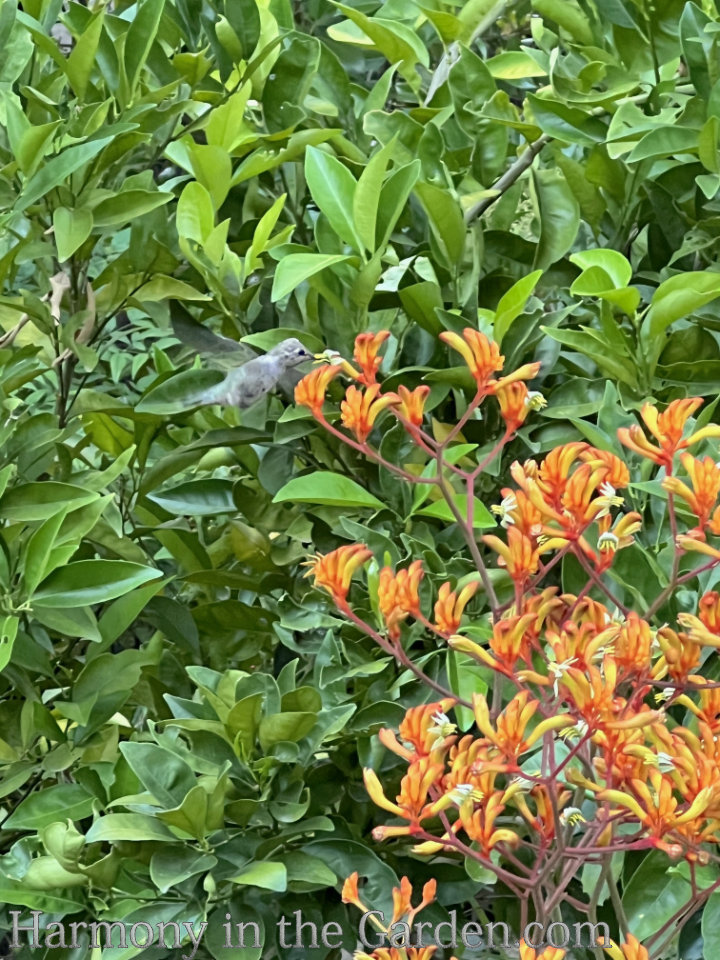
12. Allium ‘Lavender Bubbles’ zones 4-8, deer-resistant, blooms mid-late summer
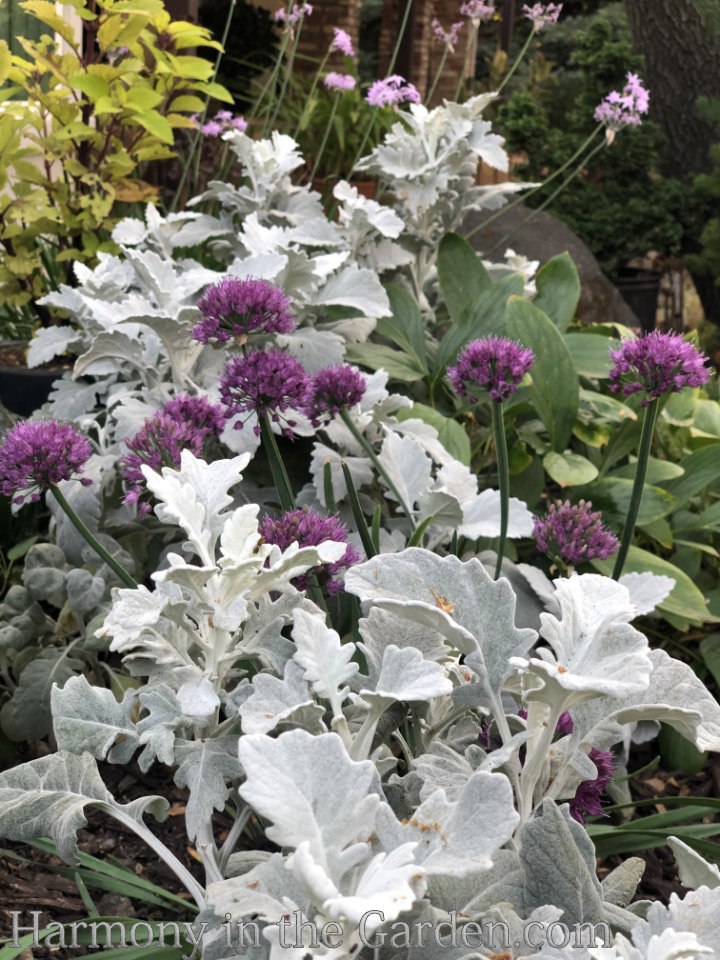
As you may know, there’s a LOT of allium varieties, but ‘Lavender Bubbles’ tends to bloom later than many of the spring bloomers.
And here’s a fun fact: did you know allium is latin for garlic?
Starting in late June and lasting through the end of July, the 2-inch purple balls float above the silver foliage of my senecio ‘Silver Gleam.’
For those of you who subscribe to Fine Gardening magazine, there’s a fantastic article about alliums, and the Chicago Botanic Garden’s trial results.
Click here to access the article online (fingers crossed the link works – sometimes their online information is limited to so many views per customer.)
And for more of my favorite ball-shaped flowers, click here (more lovely allium pics, too!)
13. Lantana (annual, except in mild climates 9-11) deer-resistant, blooms early, mid-summer and fall, too!
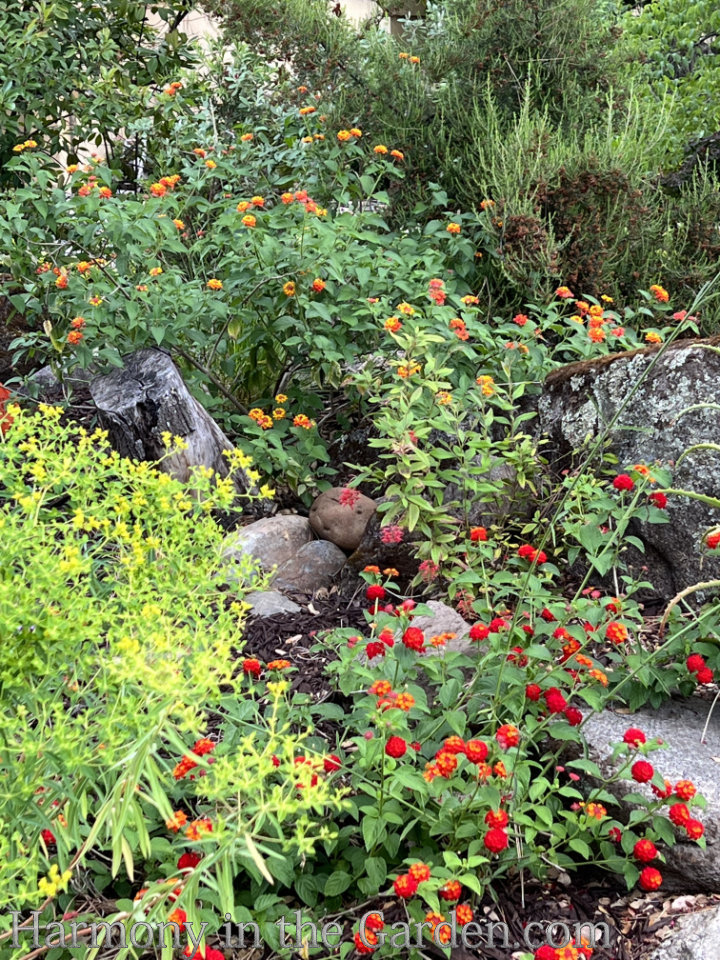
Similar to agapanthus in that I’ve typically turned my nose up at them, I’ve fallen back in love with these tough, non-stop blooming perennials.
One of my favorite varieties is ‘Dallas Red’ (in the foreground of the photo) as it has the most vibrant, rich reds and oranges I’ve seen.
The taller ‘Radiation’ is in the back, and grows to 3-4′ with softer shades of orange and yellow.
They look pretty horrible in the winter (many people think the plant has died and proceed to rip them out!) but they bounce back again once the heat arrives.
Pollinators adore them, as do hummingbirds, and deer won’t touch them.
Tons of flowers in every color imaginable, very little water, what’s not to love?
14. Bouvardia ternifolia (Firecracker Bush) zones 7-10, deer-resistant, blooms mid to late summer
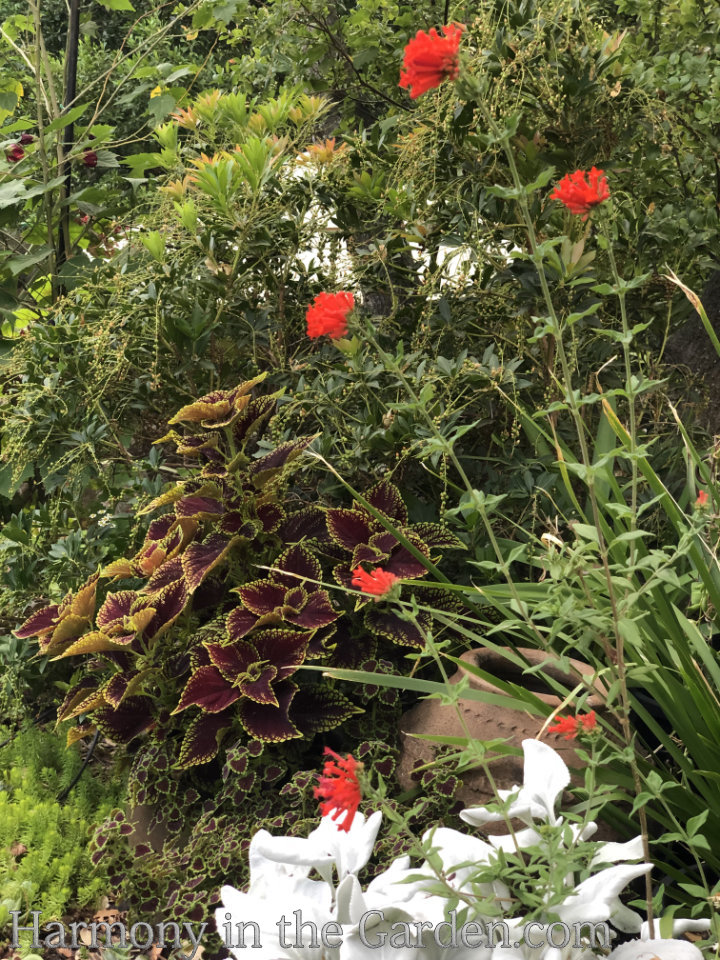
Native to the Southwest, this is an amazing perennial that will attract every hummingbird in the area to your garden.
I’ve only seen it offered once at our local nursery and wish I’d find it again, as I’d buy several more – it’s that great.
It has stiff, upright stems that reach 3-4 feet tall, and once the temps begin to heat up, the vibrant scarlet red flowers come out (and never stop until the first frost!)
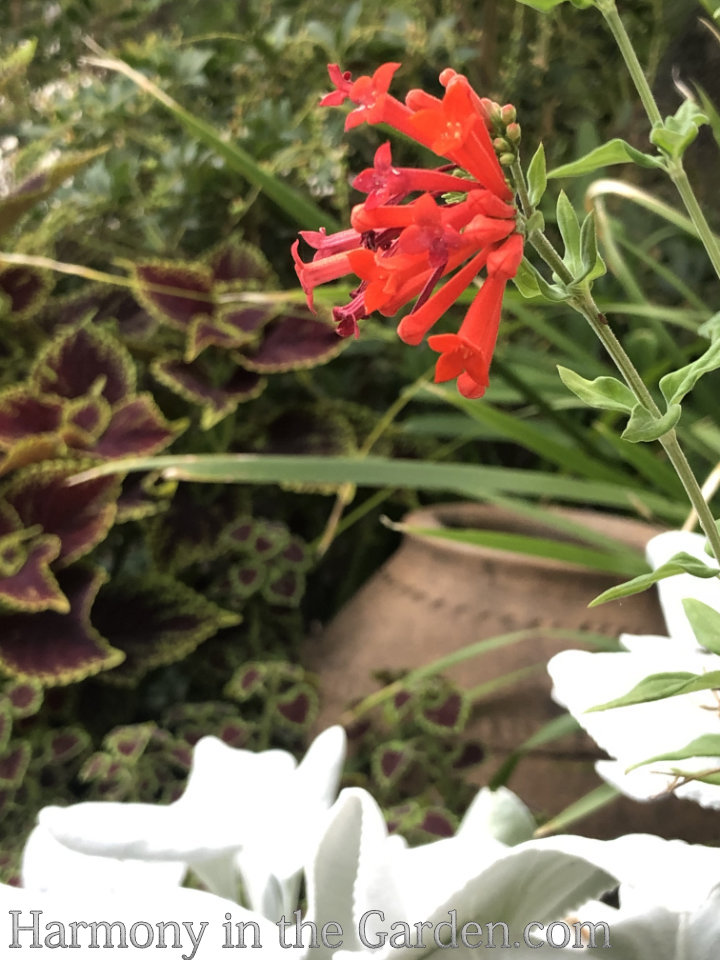
15. Salvia pachyphilla ‘Mulberry Flambe’ (Mojave Sage) zones 5-9, deer-resistant, blooms mid-late summer
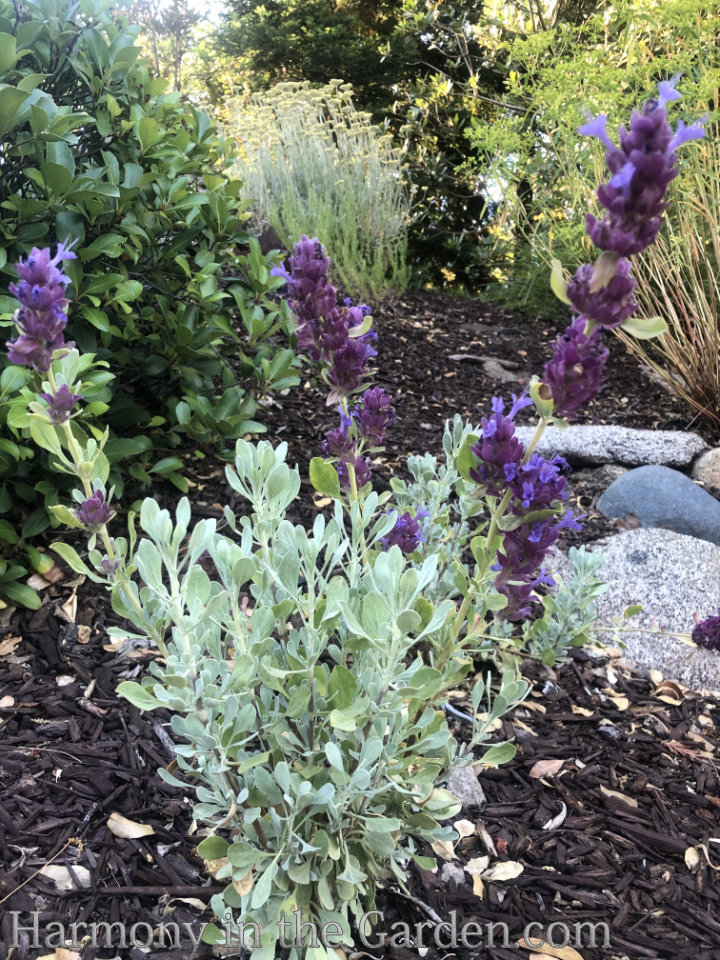
As you may recall, salvias are an integral part of my garden (click here for my favorites that bloom throughout the year.)
So when I saw the fantastic colors of these ‘Mulberry Flambe’ from High Country Gardens, I knew I had to try them.
I especially appreciate their small and compact habit, growing to just 18” x 2’.
Mine have quickly grown to full size in just a few months, and the blooms have been non-stop for three months now and counting.
As a bonus, the silvery-green-gray foliage is incredibly fragrant, smelling just like hiking in the hills.
16. Helenium ‘Short & Sassy’ (Sneezeweed) zones 4-9 & deer-resistant
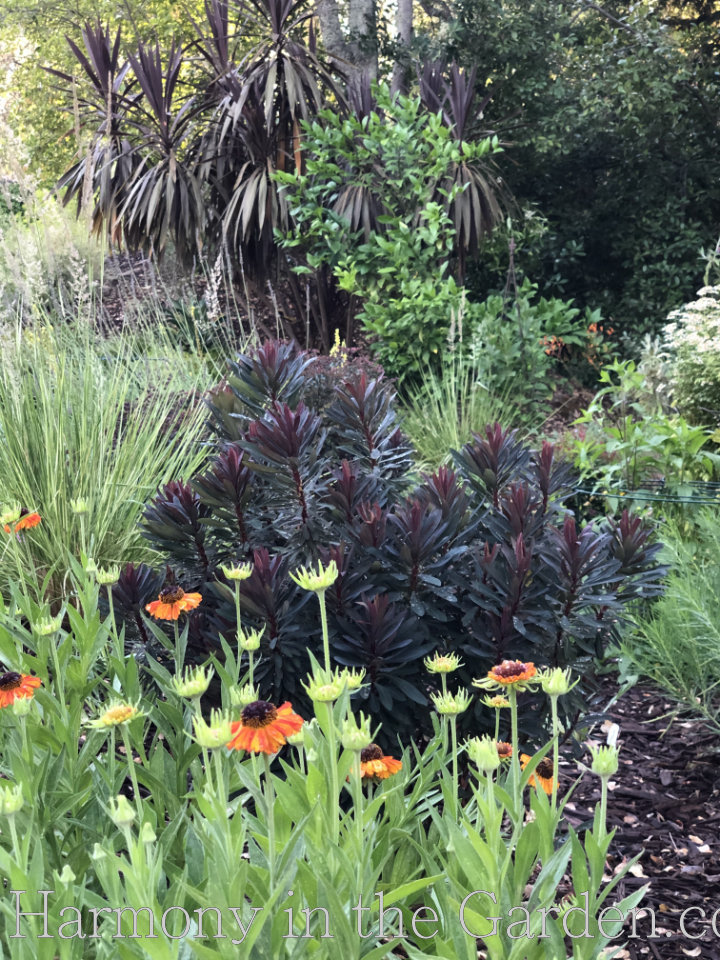
The common name of helenium is ‘sneezeweed,’ which is such an unfortunate nickname!
Contrary to popular belief, they don’t cause people to sneeze at all.
Apparently, eons ago the helenium leaves were used as some sort of snuff – hence their misleading nickname.
This compact variety has a much longer bloom time than other heleniums, and it’s the perfect size to tuck in front of my euphorbia ‘Blackbird.’
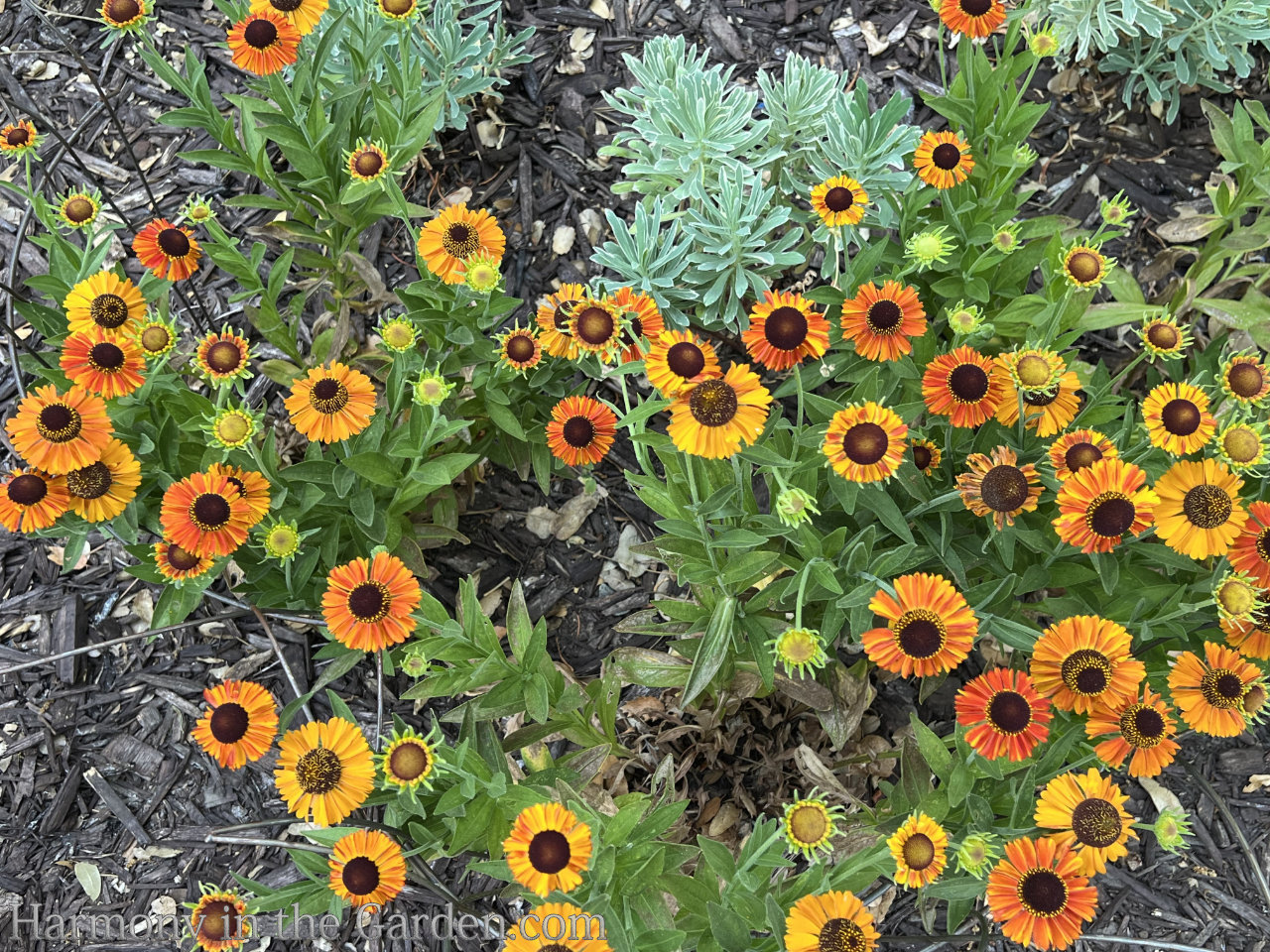
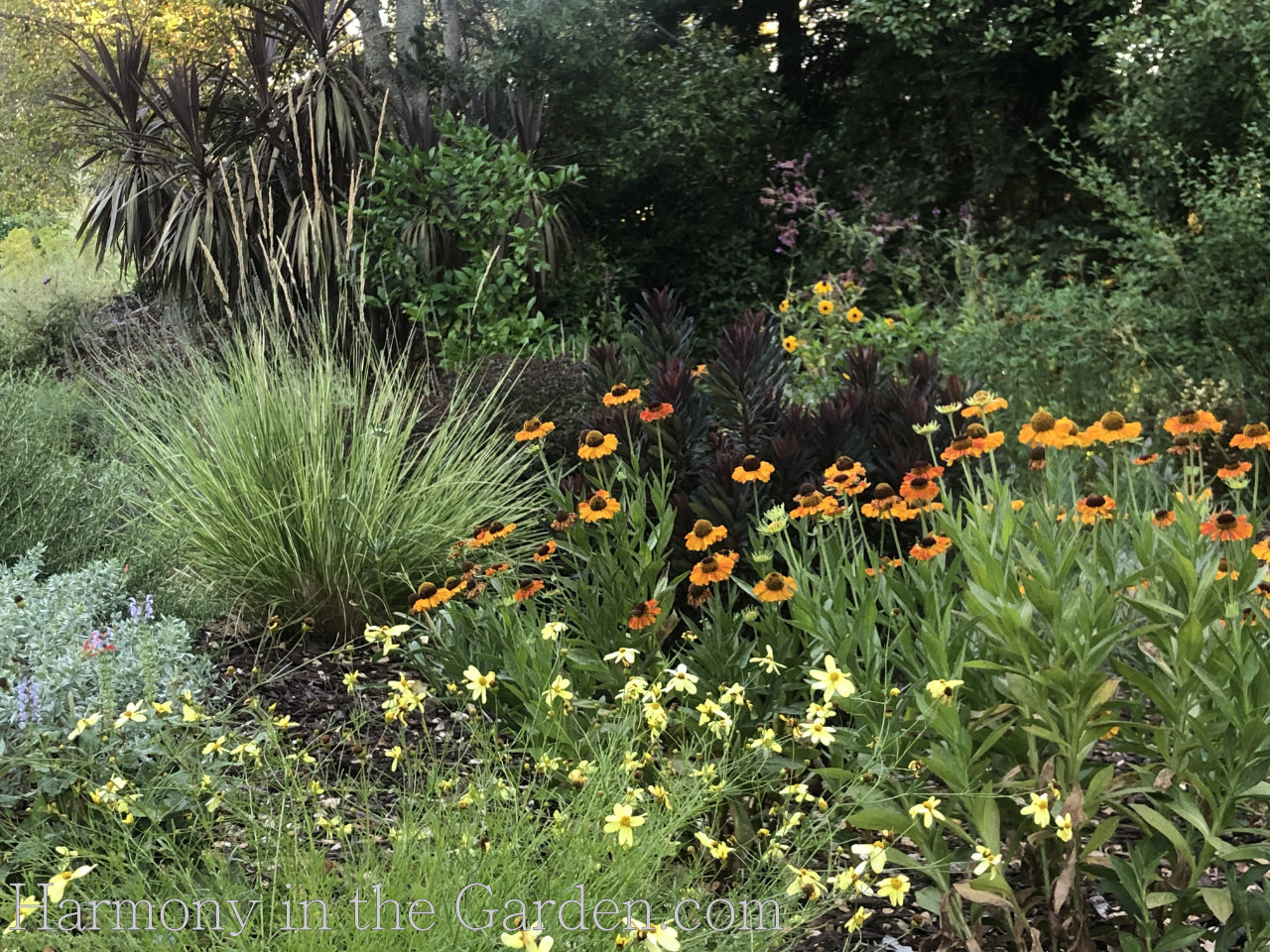
Growing to a manageable 2’x2’, ‘Short & Sassy’ pumps out the cheery orange and yellow blooms for a solid 4-6 weeks.
It does require a bit more water than the surrounding low-water perennials, but for me it’s worth it. I just love this plant.
Mine is STILL blooming after 6 weeks!
17. Echinacea pallida (Coneflower) zones 4-9, deer-resistant, blooms early summer
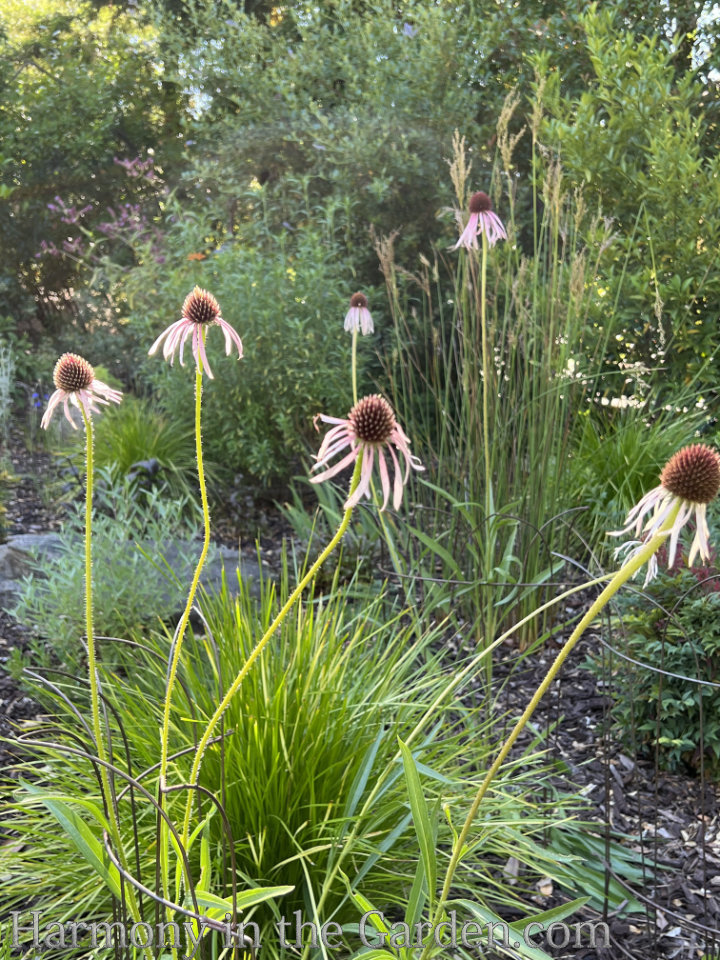
I first saw this native variety of coneflower growing in Wave Hill, and knew I had to find some for my garden.
I finally found some online from Prairie Nursery, and I’m thrilled with how they’ve thrived over the years.
Their pink petals are thinner and longer than other varieties, gently drooping downwards, appearing fragile and delicate.
They start out a brighter pink (below, left) then gradually fade to a soft, muted pink before dropping off to reveal amazing seed heads that hang on through the winter.
Once the winter winds batter the long stems to the ground, I like to gather up the dried seed heads to use as decorations (they last for years!)
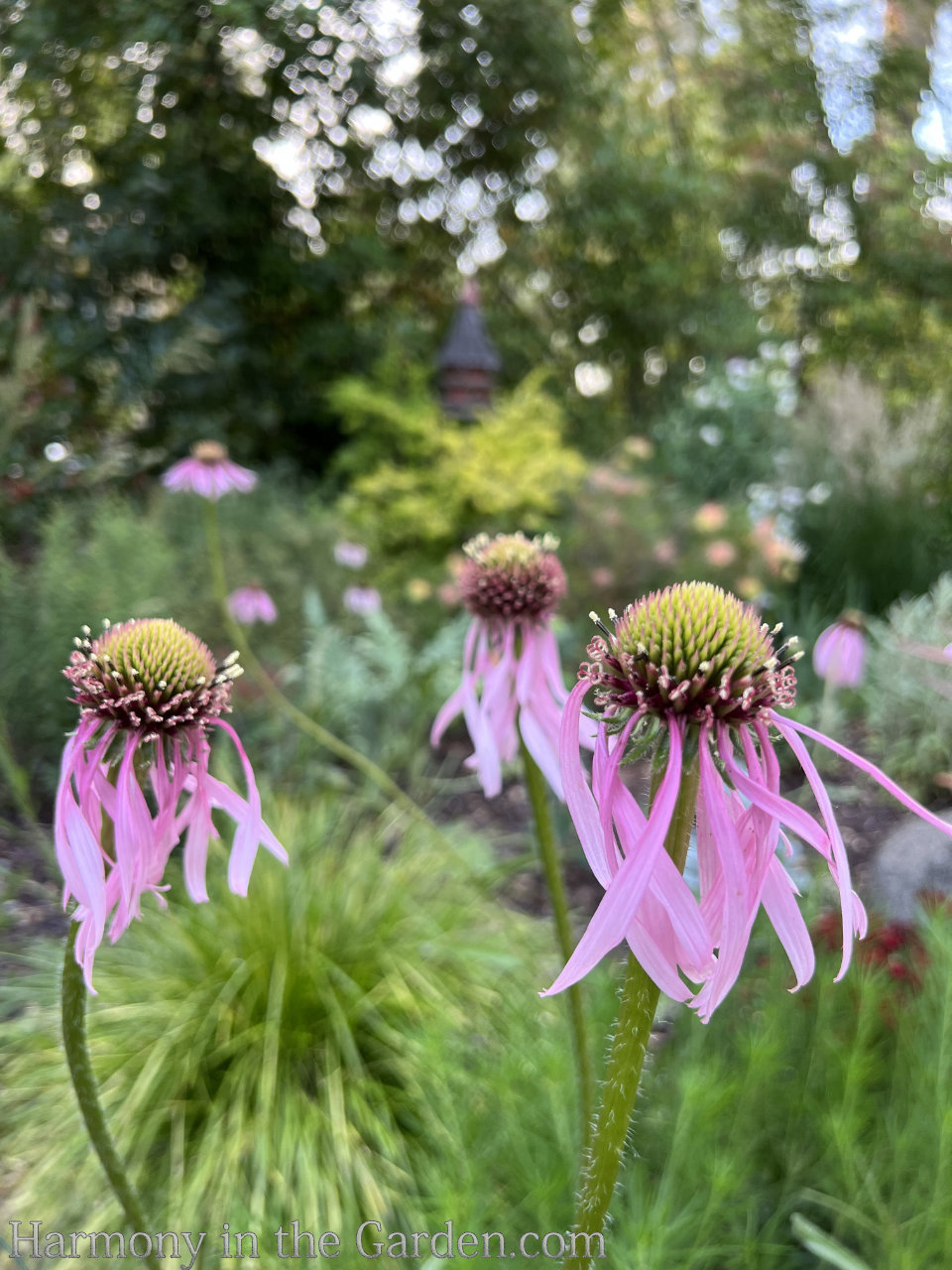
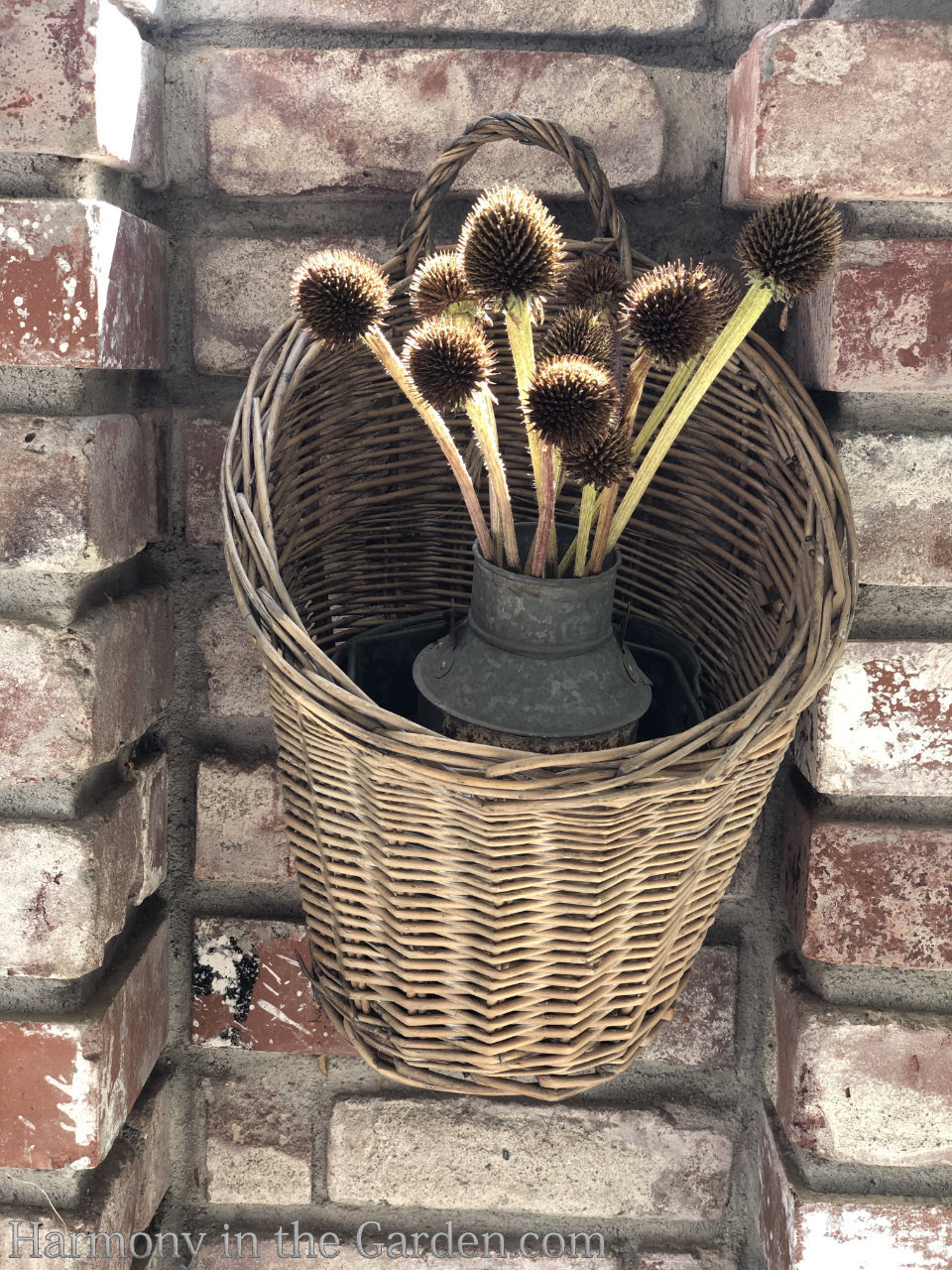
18. Rudbeckia ‘Henry Eilers’ zones 4-8, Deer-Resistant, blooms late-summer
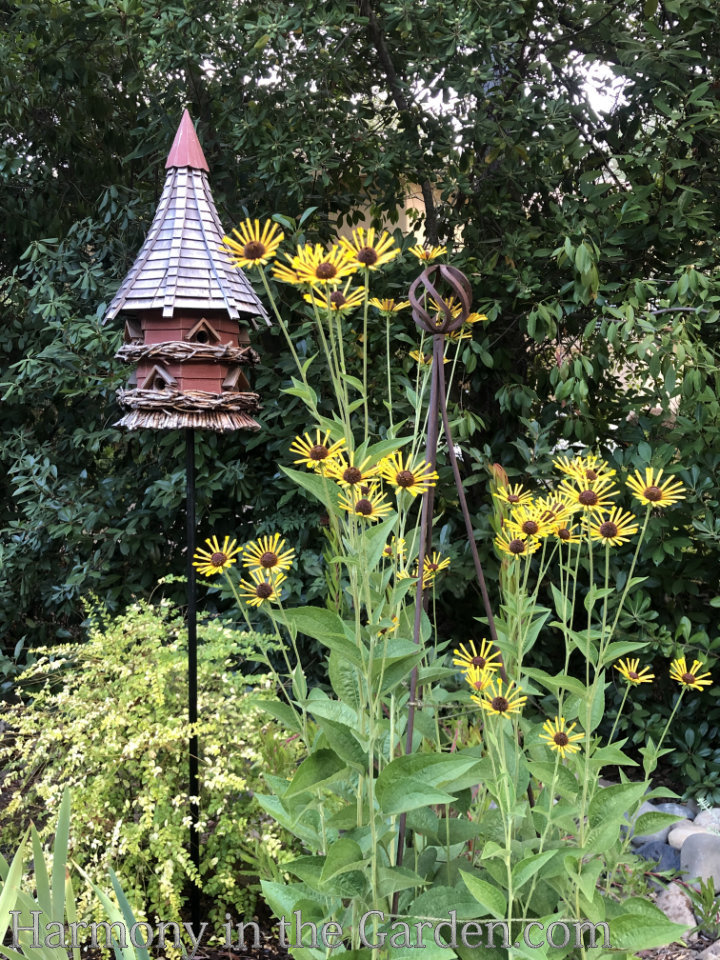
I’m a sucker for prairie plants.
Which is why when I first spotted this variety at the Bellevue Botanic Garden, I vowed to find some for my own garden.
This is a tall variety, growing to 4-5’, with tons of starry golden-yellow late-summer blooms.
While I’ve never seen them available in local nurseries, I’ve ordered mine from Bluestone Perennials.
Even though the tags say they need moist soil, mine have done really well with medium to low water. I just make sure to provide at least 3-inches of mulch to help retain the moisture.
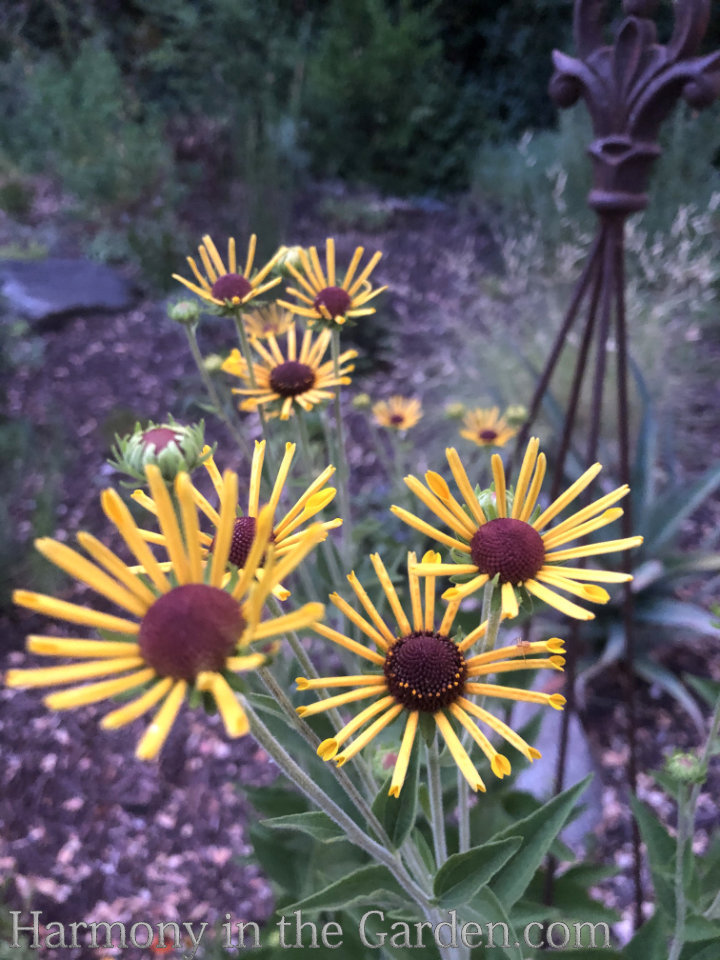
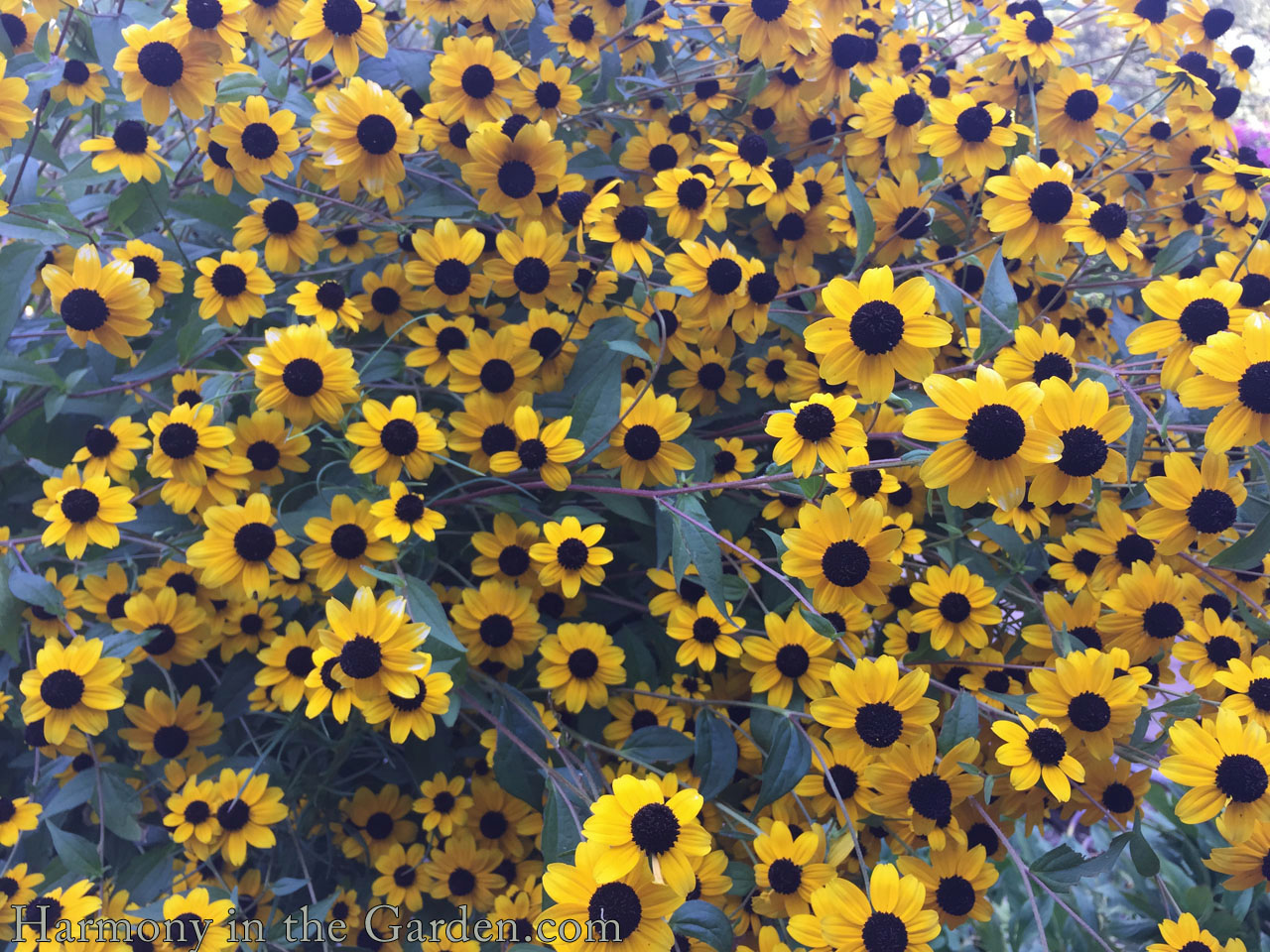
Rudbeckia triloba
(Brown-Eyed Susan) is another old-fashioned favorite in my garden, which I look forward to every summer.
Once the heat arrives, mid to late summer, it quickly grows to 4-5’ tall and is FILLED with a million little gold flowers, attracting every pollinator in town.
It’s a short-lived perennial, but since it produces a fair amount of seedlings, I always have more to plant once the mother plant eventually dies.
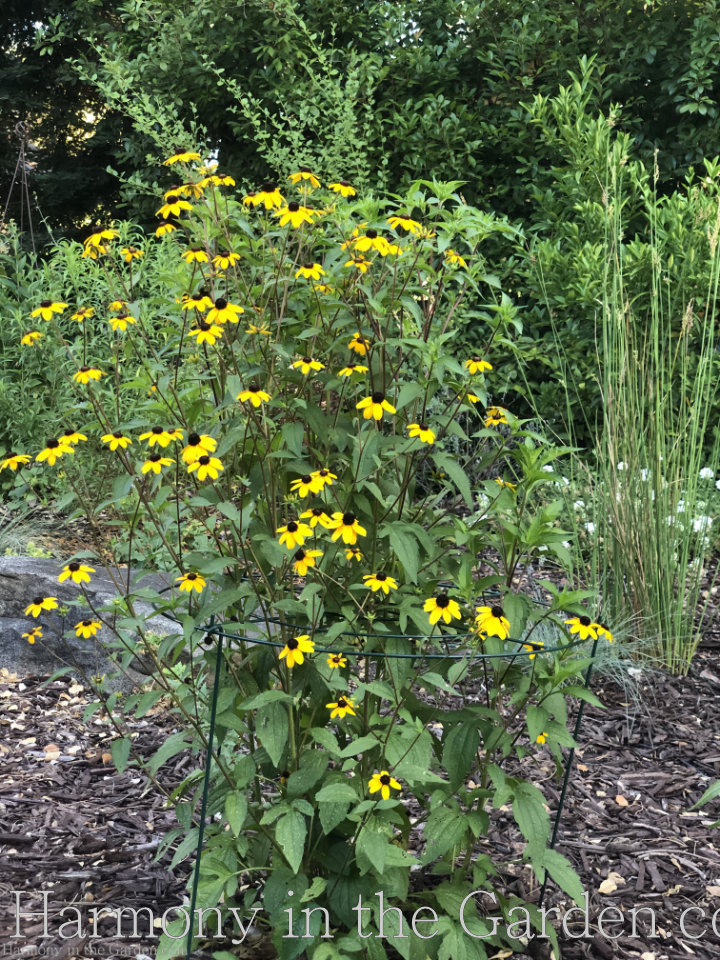
As these plants can quickly become top-heavy, I like to place peony-rings (like the ones below from Gardener’s Supply) over the top of the newly-emerging plant.
As the plant grows, the foliage and flowers quickly obscure the rings and provide a summer’s worth of support.
I also use these supports with other perennials, such as verbena bonariensis, solidago ‘Firecracker, and helenium ‘Mardi Gras’.
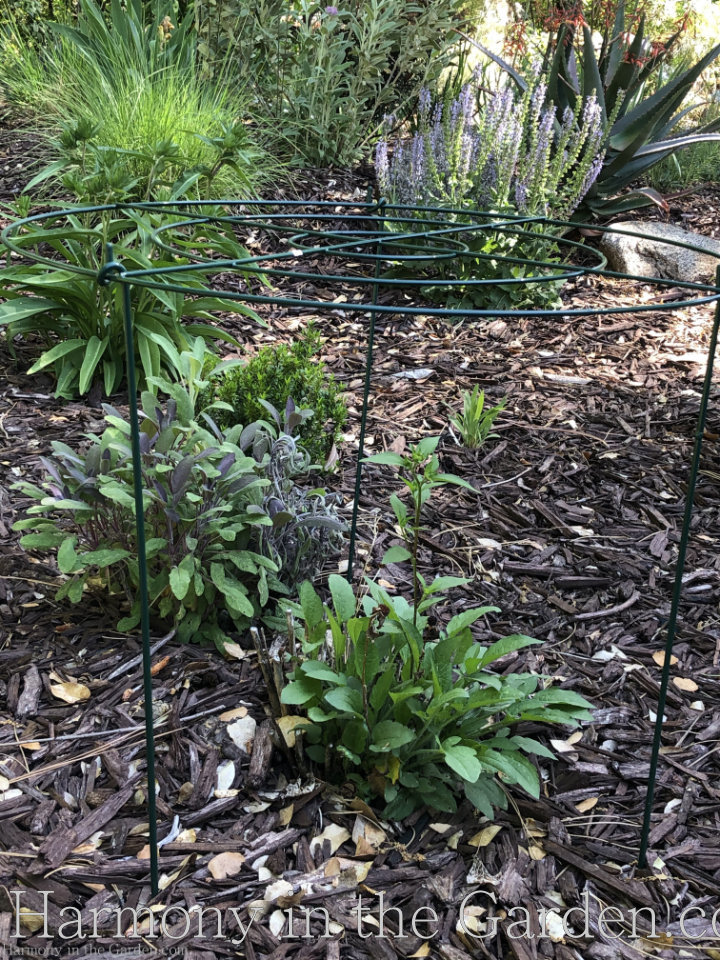
19. Eriogonum grande var. rubescens (Red Buckwheat), zones 8-10, deer-resistant, blooms early thru mid-summer
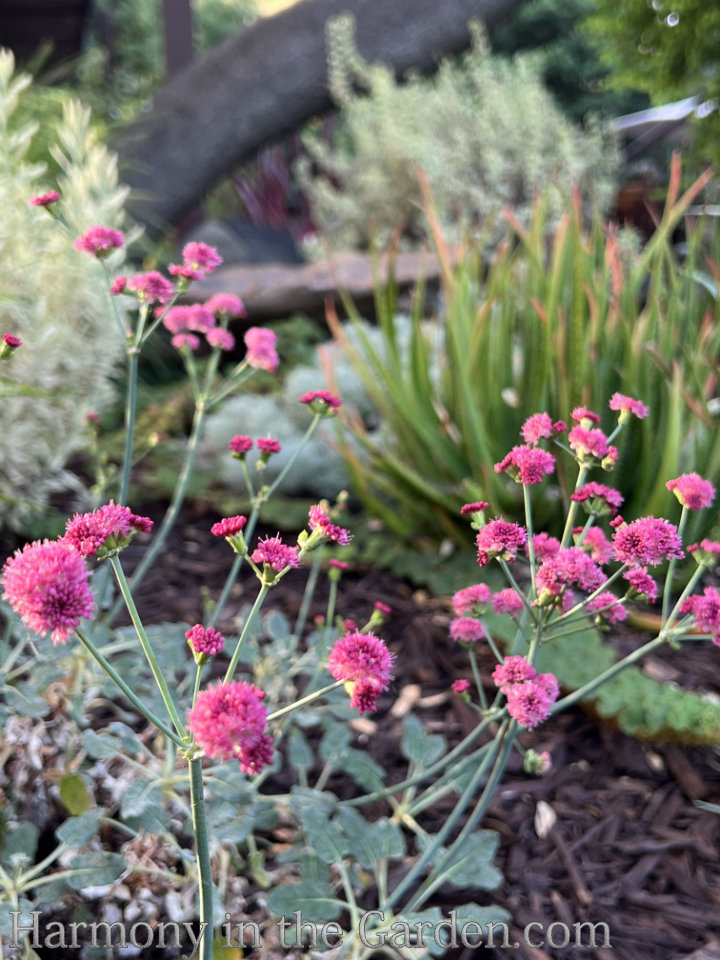
Red Buckwheat is one of my favorite little plants the front of the border, growing to a tidy 12″ x 3′ wide.
It’s native to California’s Channel Islands (which tells you it thrives in hot, dry environments!)
I have mine planted under my oak tree as it’s a very low-water plant (perfect for oaks – click here to read more!)
20. Phlox paniculata zones 4-8, deer-resistant, blooms mid thru late summer
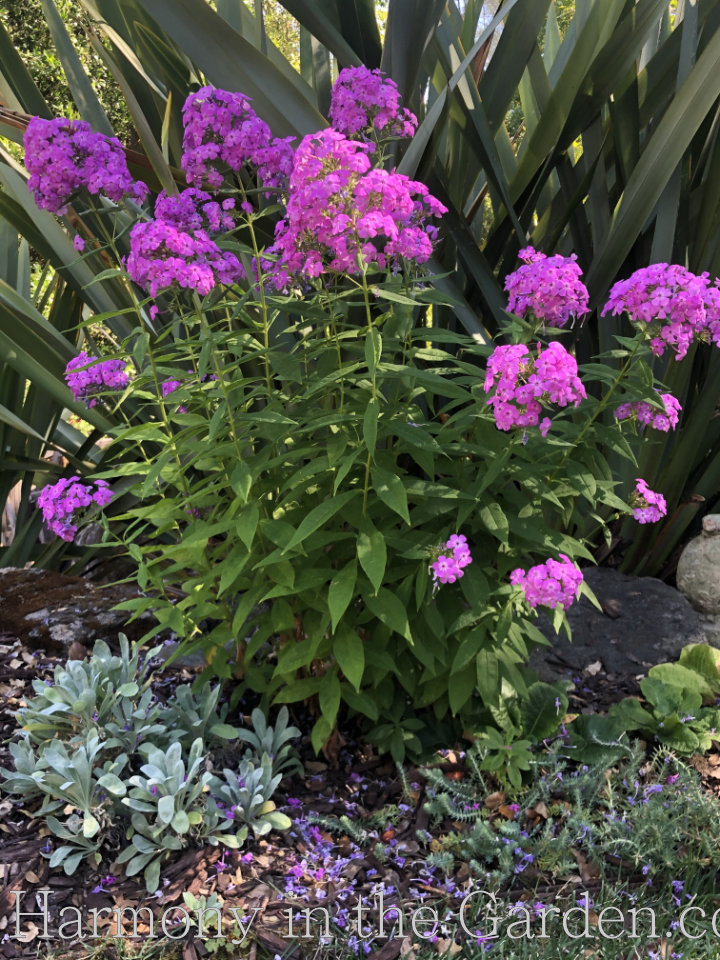
The best variety of phlox in my garden, by far, is the old fashioned (and commonly available) pink garden phlox.
This clump (left) came from my grandmother’s garden and out-performs any phlox I’ve grown before.
Blooming with 4’ tall plumes of the most delicious smelling flowers for 6-8 weeks, it attracts hummingbirds, butterflies and I’ve even spotted a hummingbird moth in the early evening!
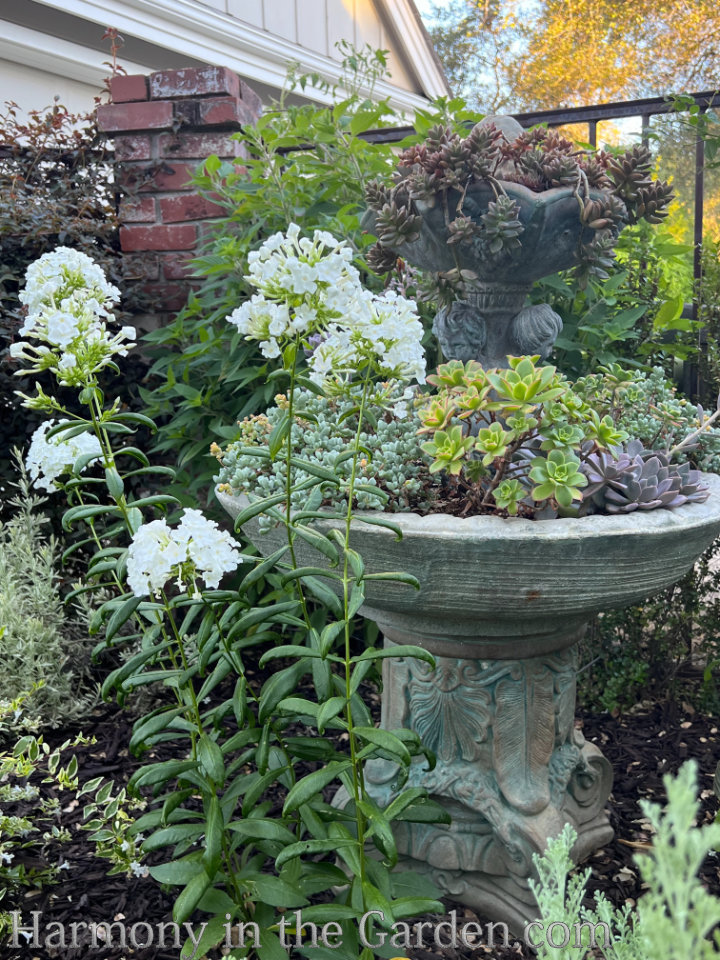
I also grow the white ‘David’s Choice’ variety (left.) ‘David’ is powdery mildew-resistant, in case that’s a problem in your garden.
‘Bright Eyes’ (below) grows in our Lake Tahoe garden and is another fabulous variety that reliably returns year after year.
And, as a side note – chipmunks and voles tend to leave this phlox alone in our garden!
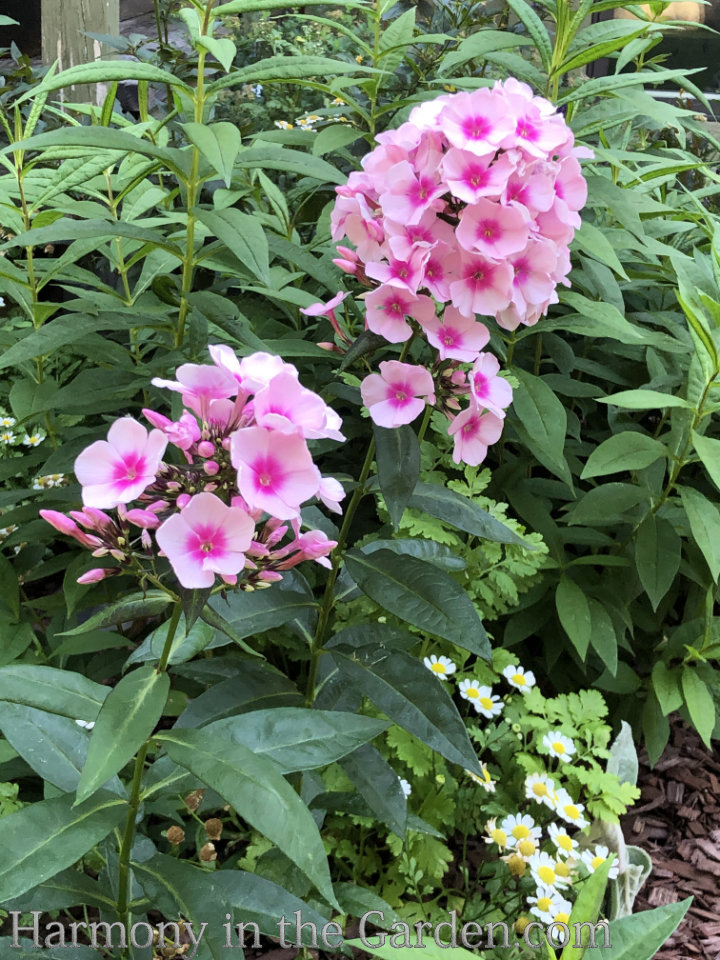
21. Leonotis leonura (Lion’s Tail) zones 8-11, deer-resistant, blooms early summer
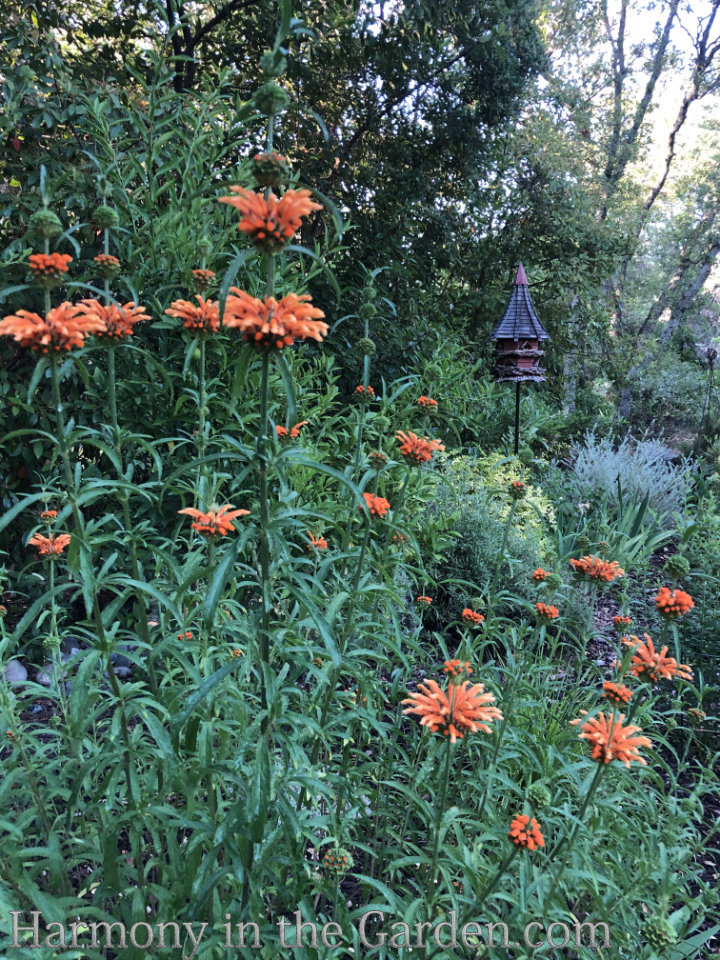
I’m so lucky Lion’s Tail is evergreen in my garden (vs. an annual in cold climates) as it’s one of my favorites for adding a long-lasting burst of orange.
However, I’ve heard repeatedly that some people are frustrated with their Lion’s Tails because they look rangy.
The trick is to give it a HARD haircut after blooming (usually mid-July) – hard, as in at least 1/2 to 2/3.
The plant will quickly bounce back and fill in with more lush, dark green growth that will soar to giant proportions once hot weather hits again next year.
The Lion’s Tail in my garden towers over 6’, and has more velvety orange flowers than I can count – it’s simply stunning!
Laughing in the face of 110-degree days, the flowers continue to bloom for several weeks, eventually forming attractive dried seed heads.
22. Hibiscus ‘Perfect Storm’ zones 5-9, blooms early thru late summer, NOT Deer Resistant!
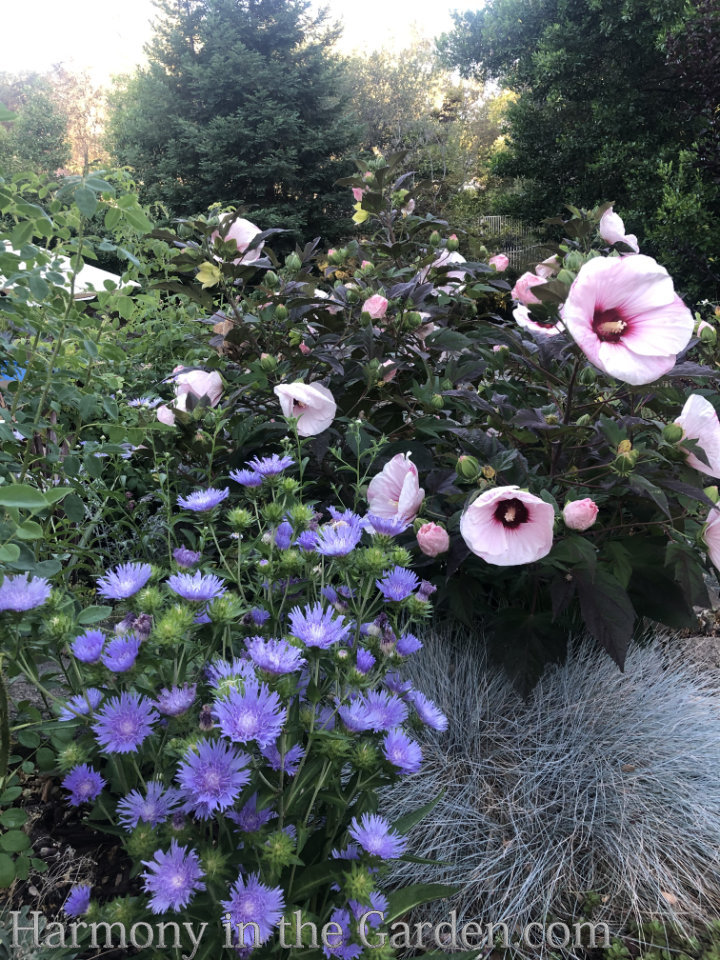
Confession: I don’t plant a lot of tropical flowers, like hibiscus, in my garden.
Yet, one of my very favorite perennials is this unbelievably tough Hibiscus hybrid.
I’ve heard from several readers that hibiscus isn’t deer resistant in their gardens, so while it’s remained untouched in mine, I’m listing it as ‘NOT Deer Resistant’ (but worth telling you about, nonetheless!)
The huge, and I mean HUGE (7-8” at least) pink and white flowers bloom non-stop throughout the summer, but honestly – it’s the foliage that I’m wild about.
Take a look at the inky, mauve and green foliage (yes, that’s another stokesia planted in front of it!)
Unlike other maroon-colored foliage that often bleaches out to green during the heat, this one holds its own throughout the summer.
It doesn’t need to be coddled, either, surviving in this hot spot in my garden without flinching. I water it, along with my other plants, 2-3 times a week during the summer – that’s it. Even during a week of 100+ temps!
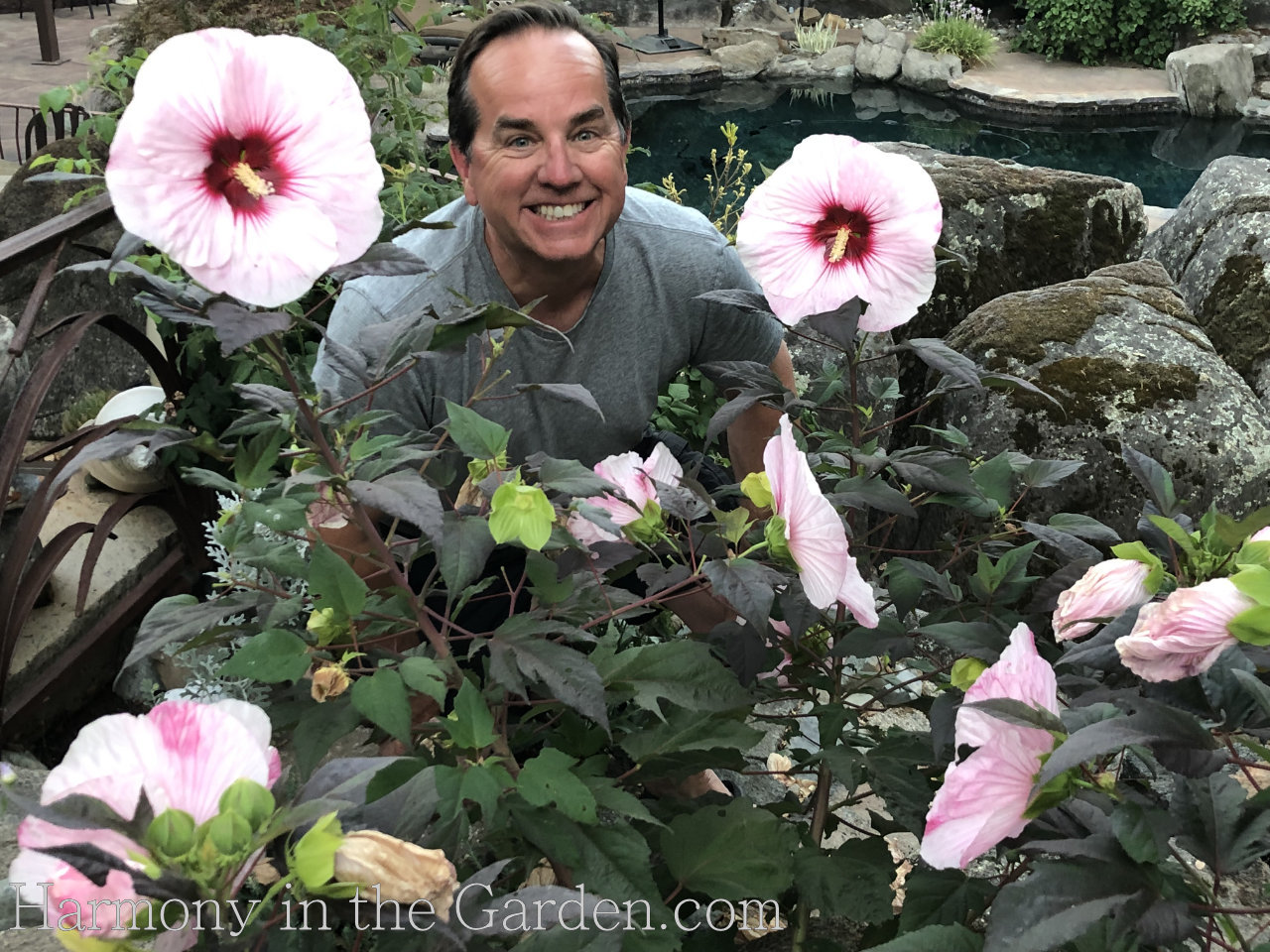
Here’s my husband, Tom, who couldn’t resist climbing in the middle of the hibiscus to show just how large the flowers are – ha!
Even though this pic looks superimposed, it’s not. And, believe it or not, Tom has a pretty large head in real life!
Pruning this hibiscus is a little different than other perennials since it’s one of the very last plants to emerge in spring.
In fact, to remind you where it’s planted, it’s best to leave a few deciduous stems standing throughout the winter.
Once it eventually emerges, it soars to 4×4 and will reward you with all the dark, dusky, flowery beauty you could want!
23. Francoa ramosa (Bridal’s Wreath) zones 7-9, deer-resistant, blooms mid thru late summer

The lovely, wispy blooms of francoa begin blooming just as the temps heat up, mid-summer.
I’ve had this francoa for many years (taking a cutting with me from my last garden) and it’s one of the toughest perennials I have.
Growing to 24″ x 24″ wide, the oversized and coarse foliage remain close to the ground most of the year.
But once mid-summer arrives, 24″ tall slender stalks of flowers appear (to the delight of hummingbirds.)
Click here to read more about how I use this plant in the garden (and to the weird stems it sometimes forms!)
24. Epilobium canum (aka: Zauschneria) ‘Everett’s Choice’ zones 8-11, Deer-Resistant, blooms late summer thru fall
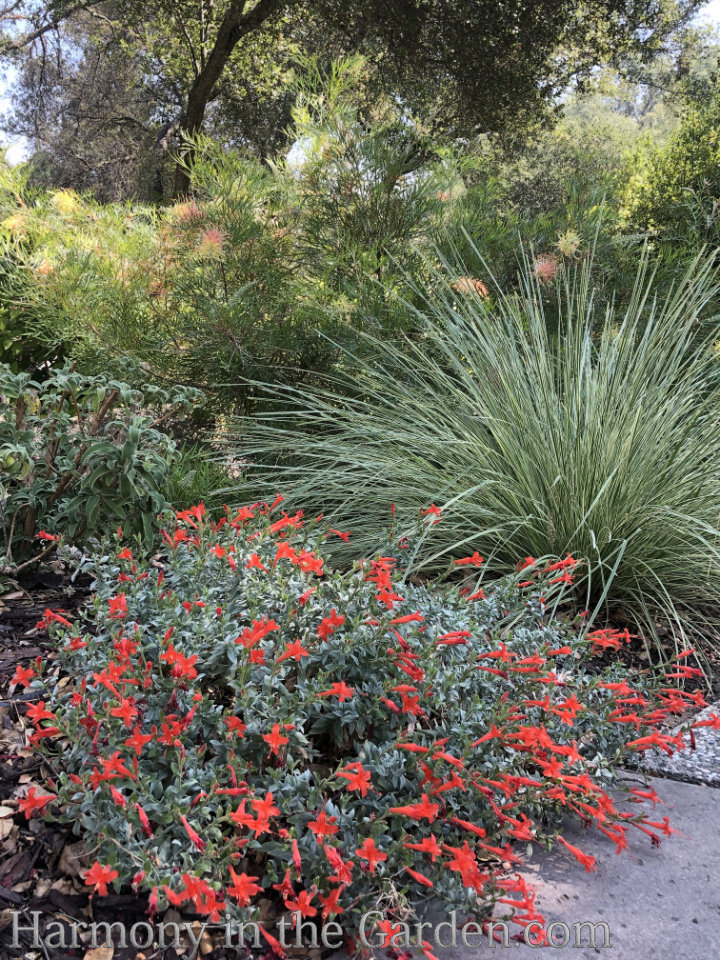
I much prefer ‘Everett’s Choice’ over other California Fuchsias, as its foliage isn’t quite as hot and gray looking as others.
This variety has more of a bluish-gray-green color to it, helping to appear more lush.
It slowly spreads to form a low 12” x 24″ mat, and only requires occasional deep watering.
The vibrant red-orange blooms appear early summer and will last through the fall, attracting tons of hummingbirds and butterflies.
Click here to read my post about my favorite Top 30 super-tough native plants.
25. Lavender stoechas ‘Javelin Forte White’ zones 7-9, deer-resistant, blooms early thru mid summer

Most lavenders are bloomed-out by now, except for Monrovia’s ‘Javelin Forte White.’
As of this post, this lavender has been blooming for 16 weeks (and counting!) and even though the plant needs to be cut back, I haven’t the heart as it’s still filled with white flowers!
When the flowers first emerge, they’re deep purple with little white tufts on the top (photo below.) But as they age, they lose their purple color and are mainly white.
Click here to read an in-depth post about all the lavenders in my garden, when they bloom, and how I prune them.
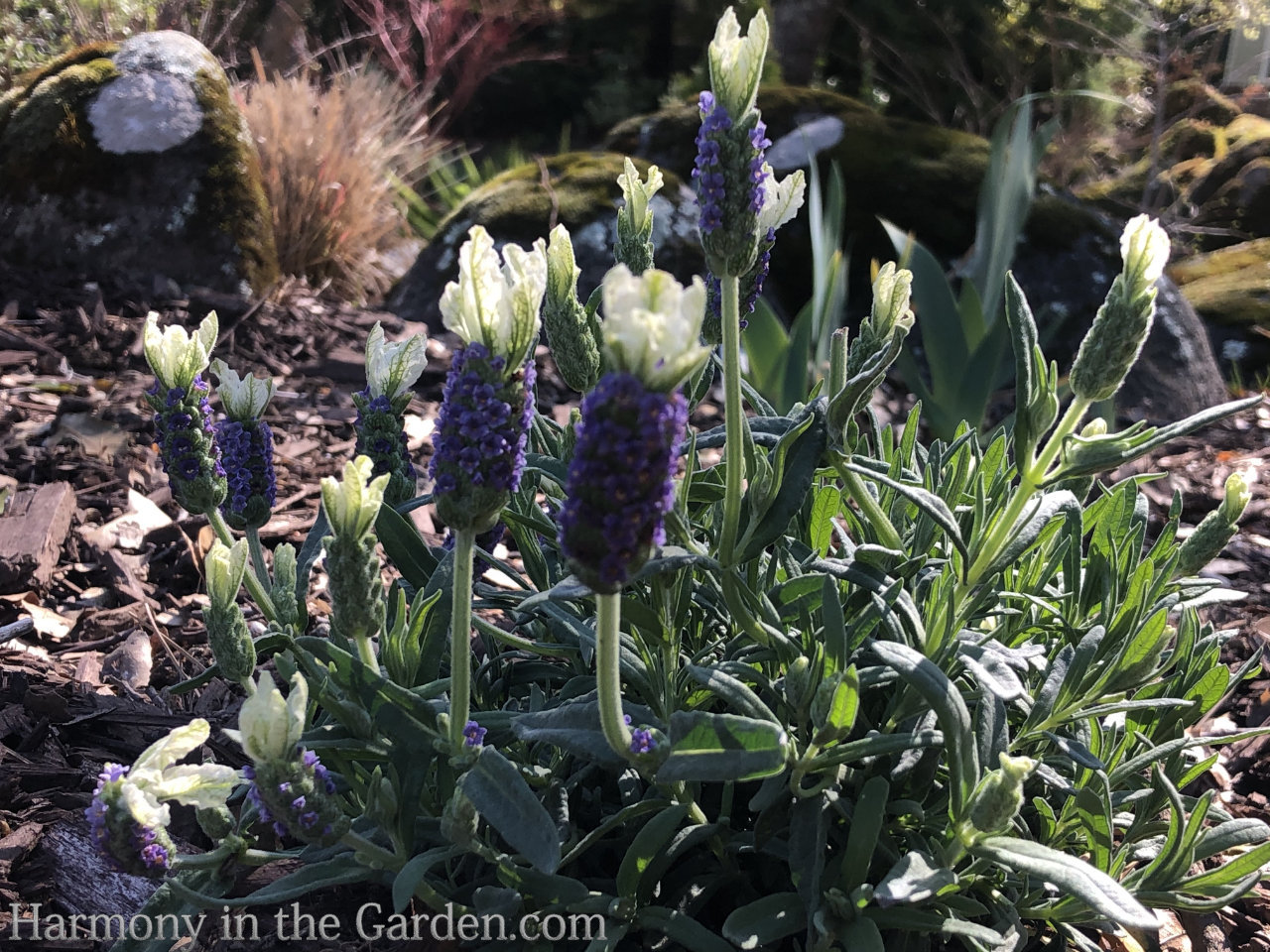
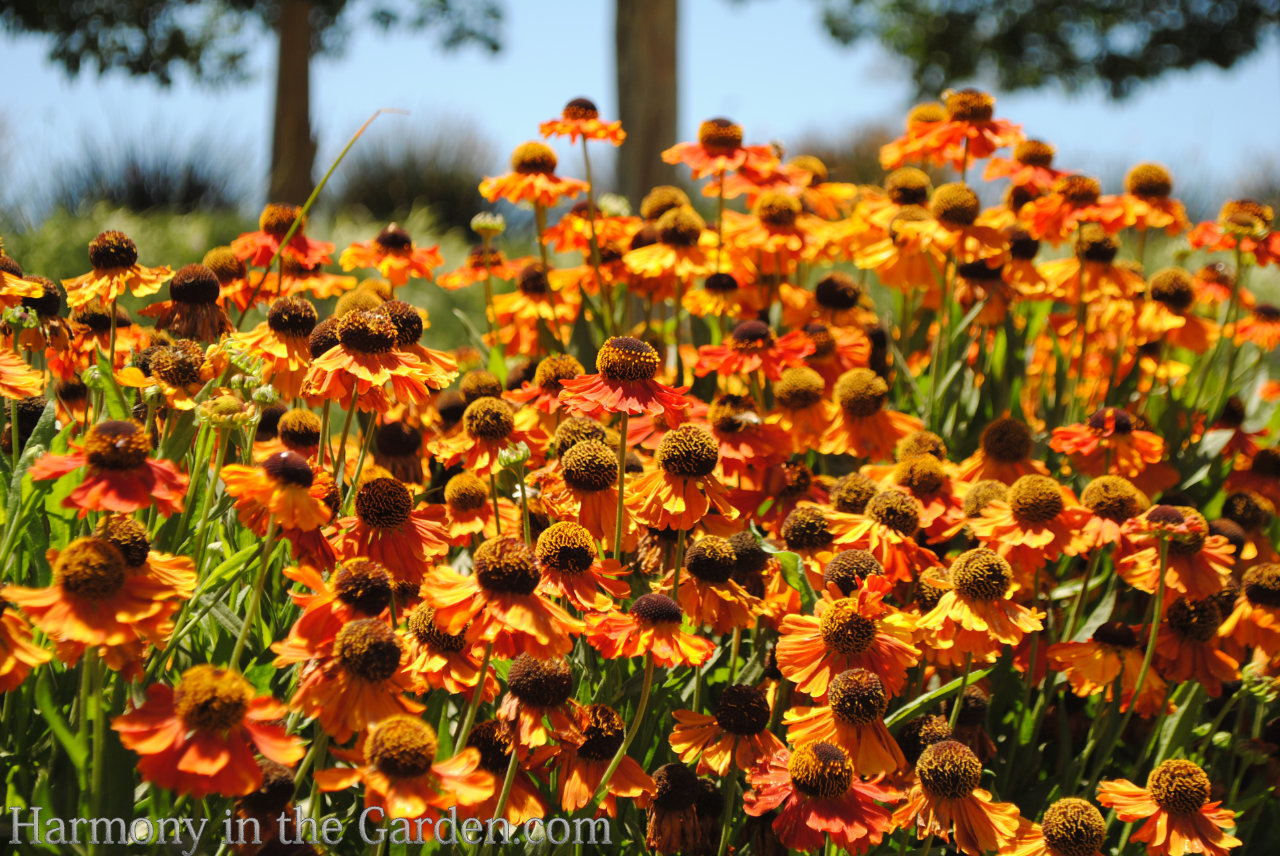
Well, there you have it – my updated list of 25 heat-loving, deer-resistant perennials!
If you’d like to see even MORE flowers in my garden that look fantastic during the hot late summer months, click here .
If you have any plants to add to this list, please share with us!
We could all use some inspiration!






36 Comments
good morning Rebecca, I just wanted to say from what I can see it looks like you have a very beautiful garden I can’t imagine how looks in person probably even better, thanks for sharing a beautiful photos I love the moment the hummingbird and it almost couldn’t find LOL.
Hello Gloria and thank you for the kind words about my garden. I love it and am glad it brings happiness to others, too. Happy Gardening! – Rebecca
Rudbeckia are absolute deer candy at our house. Every spring they come up like gangbusters and I can’t wait for them to bloom – then they are all chomped to nothing – every time they try to bounce back, the deer take them all at about 4″ tall.
Oh no – I’m so sorry your deer love rudbeckia! Mine just walk on by, never tasting a nibble (knocking on wood.) While lots of plants are deer-resistant, I’ve yet to find a single one that’s ‘deer proof’ – they all have their own distinct tastes. All we can do is keep on trying….
The one plant deer won’t eat is foxglove flowers. Digoxin, a cardiac medication, is derived from foxglove.
We have at least 4 does wandering through our yard every day. They won’t eat that, nor the other plants I have verified as deer-resistant before adding them to my garden.
Unfortunately, now we have groundhogs too, and they DO eat some plants deer don’t, so it’s back to the drawing board for me… very frustrating!
Hi Larene, as if dealing with deer isn’t enough, now groundhogs? I’m so sorry – no wonder you’re frustrated. I’ve figured out how to create a garden that’s deer-resistant to ‘our’ deer’s appetite, but I live in fear of marauding rabbits (which I’ve never seen – knock on wood) which is a whoooole other ball game. I wish you the best of luck.
Rebecca, just came across your website and saw that you are wanting to grow Bouvardia ternifolia again. I bought three plants from Annie’s Annuals in California in 2022, and I’m pretty sure they had it again in 2023. It is still listed on their website though currently out of stock. If you keep checking as we get closer to spring (mine were there in April), they might have them again, and they do mail order. I’m currently growing mine in a container and they have, indeed, proved to be deer resistant here in the East Bay Area, zone 9.
Hi Marlea and thanks so much for the information! My daughter lives near Annie’s Annuals and regularly goes ‘shopping’ for me, so I’ll add this to the list. Aren’t bouvardia just wonderful? The hummingbirds go crazy for them and love them almost as much as I do.
I’m trying to regrow my very dead garden. It’s been an epically hot summer in Central Texas and everything is DEAD. This list is really helpful but which would do best with fall planting? I’m hoping to get things in the ground by the middle of October when the weather is tolerable.
Hi Kristyn, it gets horribly hot where I live, too (lots of weeks that are 100+) However, even though we both have super hot summers, our cold temps/humidity are probably different so I would suggest doing a bit of research on the plants on my list to see just how tough they are in your area. Right off the bat, I would guess #3,6,16,18,20,23 might need too much water to fare well in your garden (these are planted in areas of my own garden that tend to have a higher water table, at the bottom of a slope, and therefore have access to a bit more water.) But I would imagine the rest would do just fine in your area as in my experience they’re low-water and have done really well in my 100+ temps. Fall is definitely the best time to plant most plants, as you know, so take advantage of the cooler temps, the winter rain, and pray next summer isn’t quite as hot!!!
my deer ate all the tops off my coral phlox this year in the front of our yard. they have also taken a liking to the pink phlox over the years in back as well.
I wish these plants were deer resistant.
Oh, I’m so sorry to hear that Kelly. I have a couple of large clumps of the old fashioned pink phlox (the one in my post) and they’ve never had even a nibble. Deer are so unpredictable, aren’t they? Though to be honest, I may have just cursed myself because as I read your comment earlier I was walking through my garden and I noticed a deer eyeing me in a frozen position about 30-feet from my phlox!
Yes, the deer love my pink phlox as well. I unfortunately forgot to spray them with Deer Stopper.
Rats. 🙁
We have found that our lantanas get mowed down by the deer. I would not include them on a list of deer resistant flowers. I do love them though. Had to move all to our enclosed backyard.
I’m so sorry your lantana was eaten by the deer! Your situation is a classic case of deer eating just about anything when they’re super hungry, as well as their preferences varying greatly by region. Which is definitely part of the reason why it’s so difficult/impossible to plan a truly deer ‘proof’ garden. The best we can hope for is ‘resistant.’ I’ve never had mine eaten either in my own garden, or those of my clients (knocking on wood as I write this!) which I think is due to the prickly, rough foliage and stems of lantana. When those deer are starving, though, I’ve even seen them try and eat cactus that are covered with wicked spikes.
Hi! I live in Rossland, BC, Canada. So zone 4 if we’re lucky! We are a mountain town so we have all kinds of wildlife. Deer, voles, and ground squirrels are the worst culprits! Some tried and true plants that seem to survive in this climate (hot and dry summers) and seem to be left alone by the wildlife are: threadleaf coreopsis, bleeding hearts, catmint, goldflame spirea, lavender, russian sage, hyssop, bee balm, salvia, foxglove, irises (siberian and german), lamb’s ears, veronica, cranesbill, oriental poppies, liatris, cushion spurge. Those ones seems to be bulletproof!
Thanks so much for this list – I’m sure lots of people will be so glad to read this! I’ve been wanting to try liatris here and will now give them a try. Luckily we don’t have voles (knock on wood) but we certainly have deer, turkeys, skunks, foxes and the occasional mole.
How do I find out what zone I live in? I live on the Olympic peninsula in Washington.
Hi Nancy, I use Sunset’s gardening zones and after a quick google search it seems yours is zone 8b. Here’s a link that explains this process: https://www.sunset.com/garden/climate-zones/sunsets-garden-climate-zones You might ask why use Sunset’s zones vs. USDA zones? “The Sunset zone maps, considered the standard gardening references in the West, are more precise than the USDA’s, since they factor in not only winter minimum temperatures, but also summer highs, lengths of growing seasons, humidity, and rainfall patterns.” Hope that helps!
I can assure you that in my garden in Virginia , deer are very fond of Platycodon, Echinacea, and Garden Phlox. All of which received a severe pruning early summer!
Oh No!!! I’m so sorry! Deer are so exasperating, with their unpredictable finicky diets. I’ll have success designing gardens in one town, with deer leaving certain plants alone, with the opposite results in the neighboring town. Your comment is the perfect example of this. Hopefully yours was just a curious deer and will leave your plants alone the rest of the time.
Hi Sweet Rebecca, Love this posting, though my entire garden is walled and there hasn’t been a deer inside here for years, but if you want to discuss ground squirrels and gophers,….well I am totally up on what they can destroy.
Love seeing all the photos, but of course my favorite is THE BOY flower Thomasii. Handsome, “Dear” tolerant, and knows how to take care of any drought.
Your blog is the only one I read. It is beautiful, well-written, and full of useful and necessary information. It fills a need! Keep going!
Sharon, we all had such a good laugh at your comment (esp. my dear-resistant Thomasii flower) Thank you so much for your encouraging words, you KNOW they mean the world to me. I saw my first ground squirrel in my garden last week and my heart sank. They’re so beautiful, but they destroy our garden at Tahoe. He was just looking around my garden here in GB with a most menacing smile on his face….
Hello…
Beautiful photos and I enjoy all the different choices to consider…thank you. I live in southern California, inland, and last spring (2021) we planted Epilobium canum in full sun. Early this spring I cut them back considerably and they bounced back but about a month ago they started showing brown, dead leaves in the middle of the plant. It’s quite unsightly. Being only the end of June, I can’t imagine how they will continue to look as the summer bears on. We water once a week for 15 minutes, twice a week if temps get into the 90’s. I would not expect them to do this until the fall after they complete the blooming cycle. Any suggestions are appreciated!
Hi Chris, I’m so glad you enjoyed this post. I read a bit about what could be causing the problems with your epilobiums, and found the best info from an article on Pacific Horticulture’s site. Here’s a little info that might help (I’ll include the link at the end.) – I hope it helps! – R For their best appearance and performance, established California fuchsia plants should be cut back hard every winter, but not until they have been established through one or two summers. This annual hard pruning should be done after the plants have finished flowering and before new growth appears. At this time, plants should be cut to the ground, leaving stubs about one inch long. When pruning, take care to avoid breaking off the tender young shoots and buds that may already be sprouting from the base of each plant.
If plants do not receive this annual pruning, new growth will appear at the tips of the existing stems as well as from the base of the plants; however, the new basal shoots often die from lack of sunlight caused by excessive shading from both dead and live material above. This unfortunate attribute helped establish California fuchsia’s reputation as an unkempt, wildlooking plant. https://www.pacifichorticulture.org/articles/enjoying-zauschnerias/
Rebecca,
Thanks so much for this article! I am definitely going to add some of these plants. I’ve learned so much from you and I love the way my garden is evolving based on your guidance. I am especially excited about adding some of your smaller plant recommendations to the small border near my pool – in the blazing hot sun!
Not only is your article full of great ideas, but you have timed it perfectly (hot, hot, hot)
Hi Cathy! I hope your garden has survived the heat over the past 10 days – omg hasn’t it been just awful? Thanks heavens it’ll be a little cooler tomorrow (doing the happy dance.) I’d love to see progress pics of your garden sometime! Take care and stay cool xoxo
Hi Rebecca,
I just love looking at all your garden photos. Up here in WA state, we have been below normal temps, (I’m not complaining). You offer so many wonderful solutions to every garden issue. You are amazing! (Love the photo of your husband, would that flower work up here)?
Miss seeing you.
Gigi
Thanks so much, Gigi, and YES – you should definitely try Tom up there, he does really well in gardens (as would the ‘Perfect Storm’) 😉
Rudbeckia and coneflowers are definitely not dear resistant I have them in my yard and the deer eat them constantly it’s to the point now where I’m going to pull them out as they never have a chance to bloom they also eat the leaves on them as well in addition this post or blog says that agapanthus are not dear resistant but actually those ARE dear resistant because they are poisonous plants and deer do not eat poisonous plants that’s why they don’t touch daffodils or fox gloves because their poisonous I have all three of these plants in my yard and the deer do not touch them. in addition allium are part of the onion family they’re not part of the garlic family.
Hi KE – lucky you to have your agapanthus blooming among the deer, the ones in my area 100% get wiped out just as they’re putting on a show. You bring up a good point which is that a deer’s appetite varies region by region. What might be eaten in your garden, isn’t eaten in mine. Over the past 20 years, I’ve noticed this extensively. In my neighborhood, hydrangeas are also deer-resistant believe it or not, as they’re typically notorious for being munched to the ground by deer. I have neighbors who also have lots of roses in their garden that seem to be untouched by deer, which is amazing to me. That’s why it’s important to say deer ‘resistant’ and not deer ‘proof’ as those pesky deer will eat just about anything if they’re hungry enough. btw: I said allium is latin for garlic, not that it’s in the garlic family.
Love your blog: the pictures and comprehensive information is outstanding.
I live in central Texas, which is definitely a hot zone. Usually, our concern is the heat and lack of rain. But this year and last year there was an added challenge – minus 6 temperatures for several days in a row. Here are my four top favorites that have endured the heat, and now the cold, for at least 15 years.
Globe Amaranth, also known as ‘Strawberry Fields’ Gomphrena (Gomphrena haageana)- It prefers dry, hard ground and grows in our caliche. Other pluses: needs very little water, reseeds freely, and is a beautiful, bright red spot in the garden.
Henry Duelberg Sage or Mealy Cup Sage (Salvia farinacea ‘Henry Duelberg’) – thrives on heat and some water, it reseeds and will come up in fields outside the yard. It was discovered growing on a grave in LaGrange, Texas.
Turk’s Cap (Malvarisus arboreus) has large leaves and a unique red flower. It will grow in full sun or shade. Pollinators love it.
Texas Gold Columbine (Aquilegia chrysantha hinckleyana ‘Texas Gold’) – It’s a spring bloomer, has fascinating flowers, and tends to be evergreen in mild winters
All of these are Texas Superstars – a plant selection with trial periods associated with Texas A&M.
Hi Wanda, thanks so much for your compliments and welcome to my blog! I’m SO happy you mentioned ‘Strawberry Fields’ as it’s one of my favorite annuals, but I haven’t planted it in years. Next time I see it, I’m definitely going to try it in my garden now that I know it’s so darn tough! I have the Turk’s Cap and boy, do the deer like it 🙁 I’ve had to move it a few times, but now it’s finally happy. I haven’t tried ‘Henry Duelberg’, but after reading about the description on Plant Delight’s site (and your personal testimony!) it’s also on my list. Here’s what they said – pretty interesting: From Greg Grant’s infamous cemetery wanderings comes another clone of Salvia farinacea, this one from the Texas gravesite of Henry Duelberg. ‘Henry’ is a bit taller than his better half (Salvia farinacea ‘Augusta Duelberg’), making a 2′ tall x 3′ wide clump of glossy, green foliage, topped with long 1′ spikes of dark royal purple-blue…a hangout for hummingbirds. This phenomenally heat- and drought-tolerant selection is for the full-sun gardener who kills everything else. Soggy soils are about the only thing that will send these to meet their namesakes. Thanks again for your fabulous suggestions!
Greg Grant is a much-loved speaker in Texas and quite a character. About Henry Duelberg, he said, “If the dead can grow it, then so can we.”
That’s such a funny quote, Wanda – I certainly won’t forget it now! 🙂